
1TestItemFile
MULTIPLE CHOICE. Choose the one alternative that best completes the statement or answers the question.
Name the quadrant in which the point is located.
1) (6, 15)
A) I B) II C) III
Objective: (1.1) Rectangular Coordinates
2) (-18, 6)
A) I B) II C) III
Objective: (1.1) Rectangular Coordinates
3) (-7, -10)
A) I B) II
Objective: (1.1) Rectangular Coordinates
4) (12, -18)
IV
IV
III
IV
A) I B) II C) III
Objective: (1.1) Rectangular Coordinates
Identify the points in the graph for the ordered pairs. x
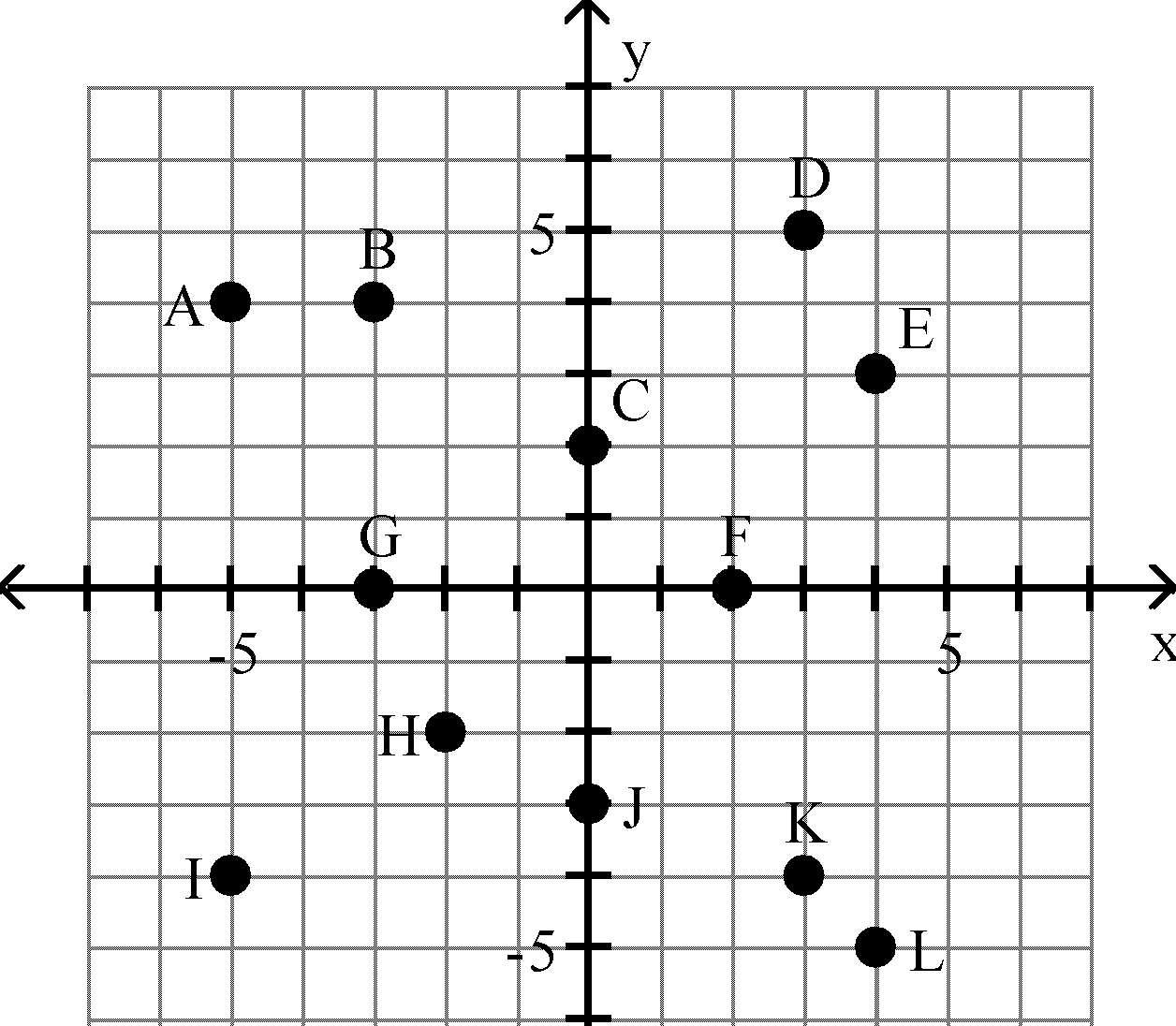

5) (0, 2), (4, 3)
A) B and C
B) C and E
Objective: (1.1) Rectangular Coordinates
6) (-5, -4), (0, -3)
A) A and G
B) I and J
Objective: (1.1) Rectangular Coordinates
7) (-3, 4), (2, 0), (4, -5)
A) B, F, and L
B) F, K, and L
Objective: (1.1) Rectangular Coordinates
C) C and K
IV
D) F and E
C) G and I
D) A and J
C) B, C, and L
D) A, B, and F
8) (3, 5), (-3, 0)
A) L and J B) I and G
Objective: (1.1) Rectangular Coordinates
Give the coordinates of the points shown on the graph.
9) x


A) A = (7, 24), B = (5, -2)
C) A = (4, 7), B = (5, -2)
Objective: (1.1) Rectangular Coordinates
10) x
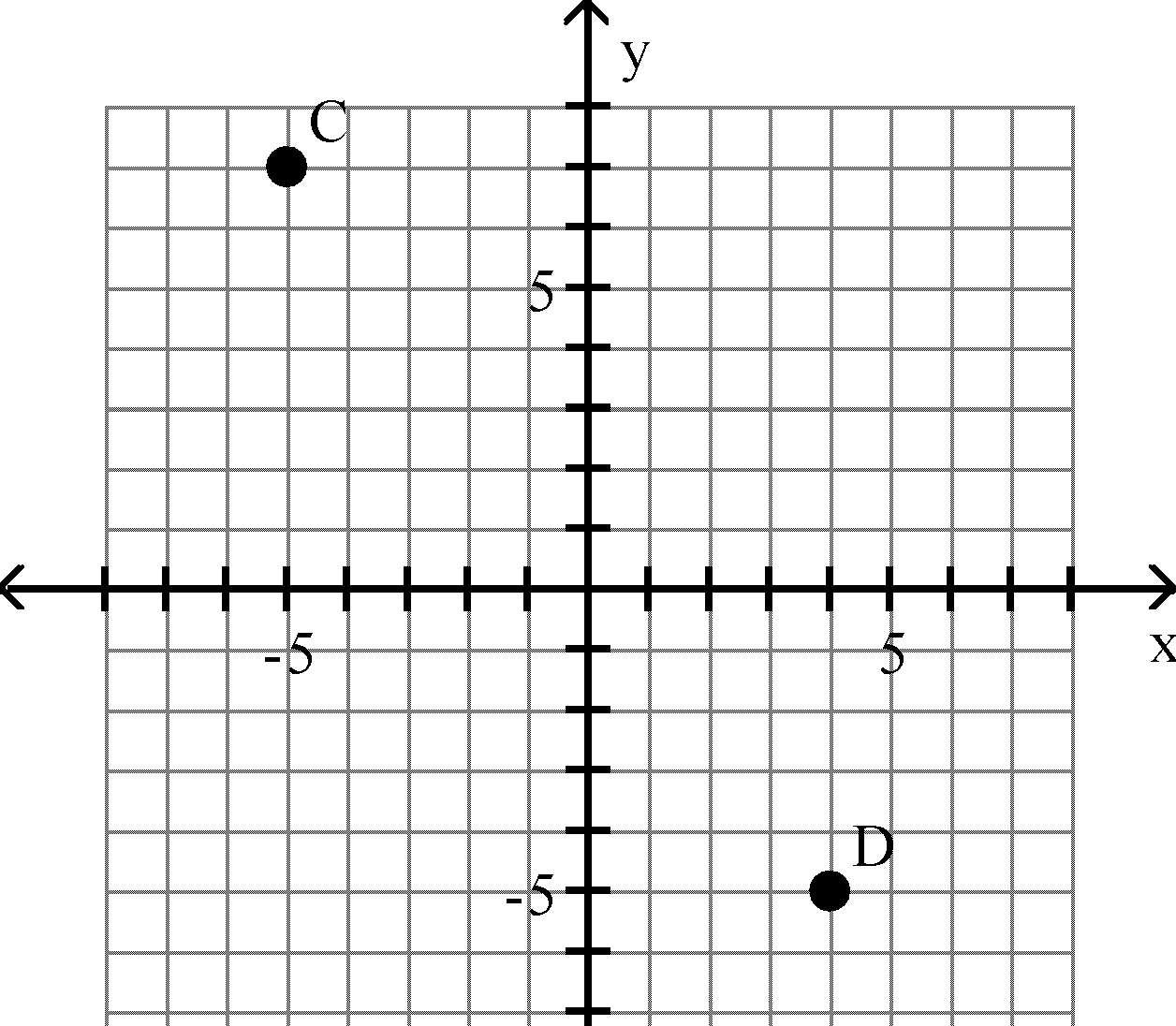

A) C = (-5, 7), D = (-5, 4)
C) C = (-5, -5), D = (7, -5)
Objective: (1.1) Rectangular Coordinates
C) D and J D) D and G
B) A = (4, 5), B = (7, 5)
D) A = (4, 7), B = (-2, 5)
B) C = (-5, 7), D = (4, -5)
D) C = (7, -5), D = (-5, 4)
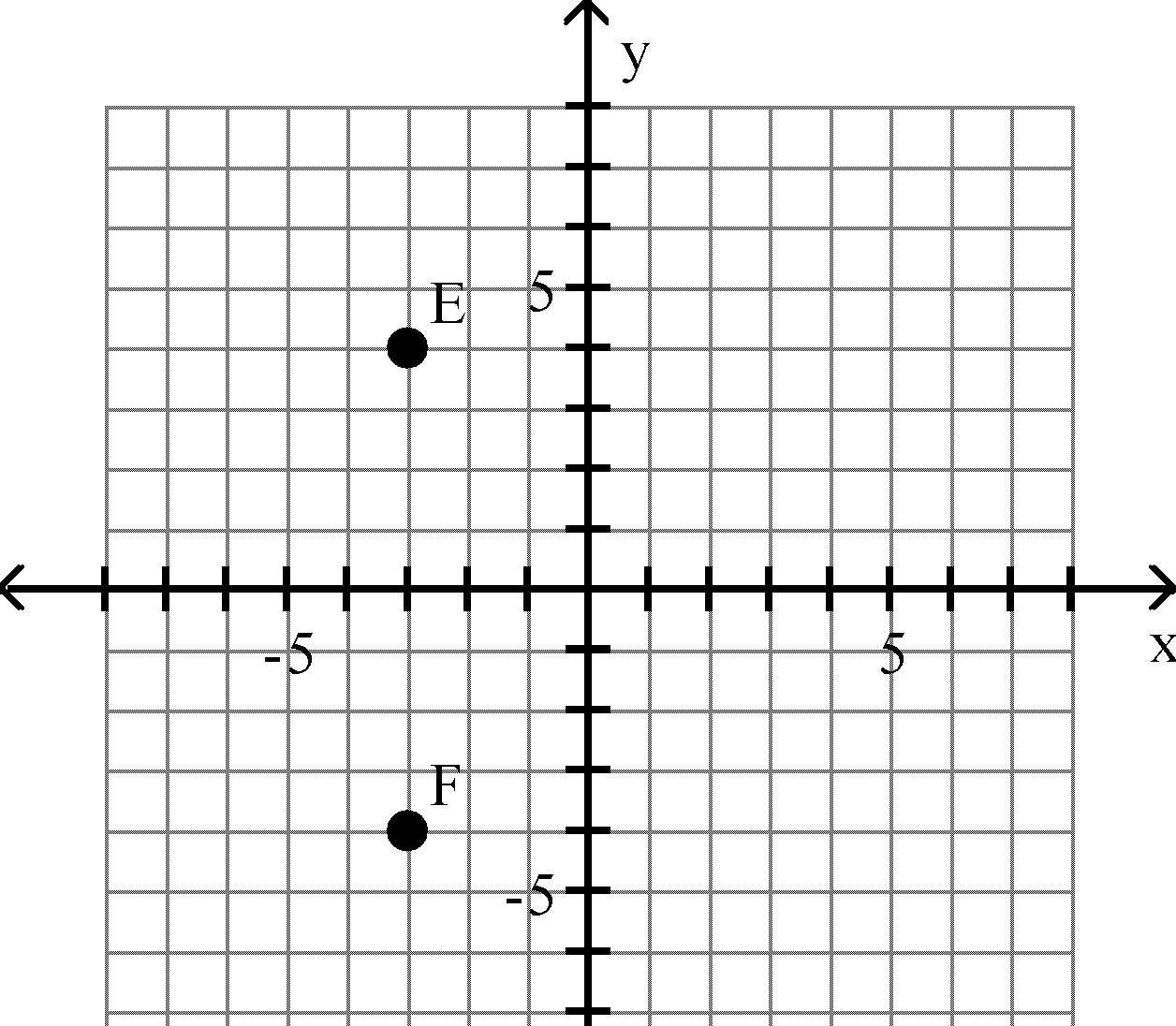

A) E = (-3, 4), F = (-3, -4)
C) E = (4, -3), F = (-4, -3)
Objective: (1.1) Rectangular Coordinates
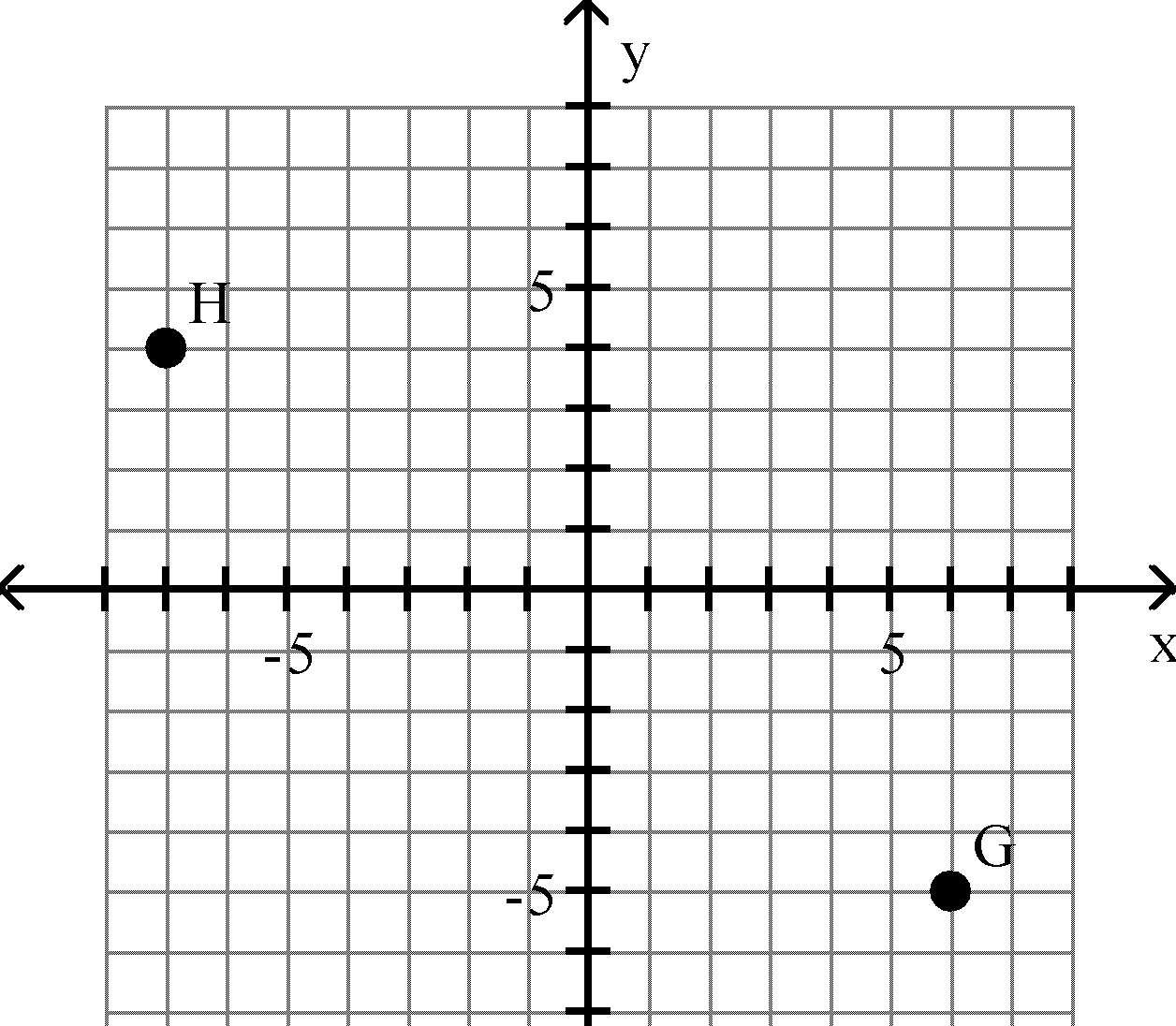

A) G = (-5, 6), H = (4, -7)
C) G = (6, -5), H = (-7, 4)
Objective: (1.1) Rectangular Coordinates
B) E = (-3, -4) , F = (-3, 4)
D) E = (-3, -4), F = (4, -4)
B) G = (6, 4), H = (-5, 4)
D) G = (6, -5), H = (4, -7)
Plot the point in the xy-plane. Tell in which quadrant or on what axis the point lies. 13) (1, 6)



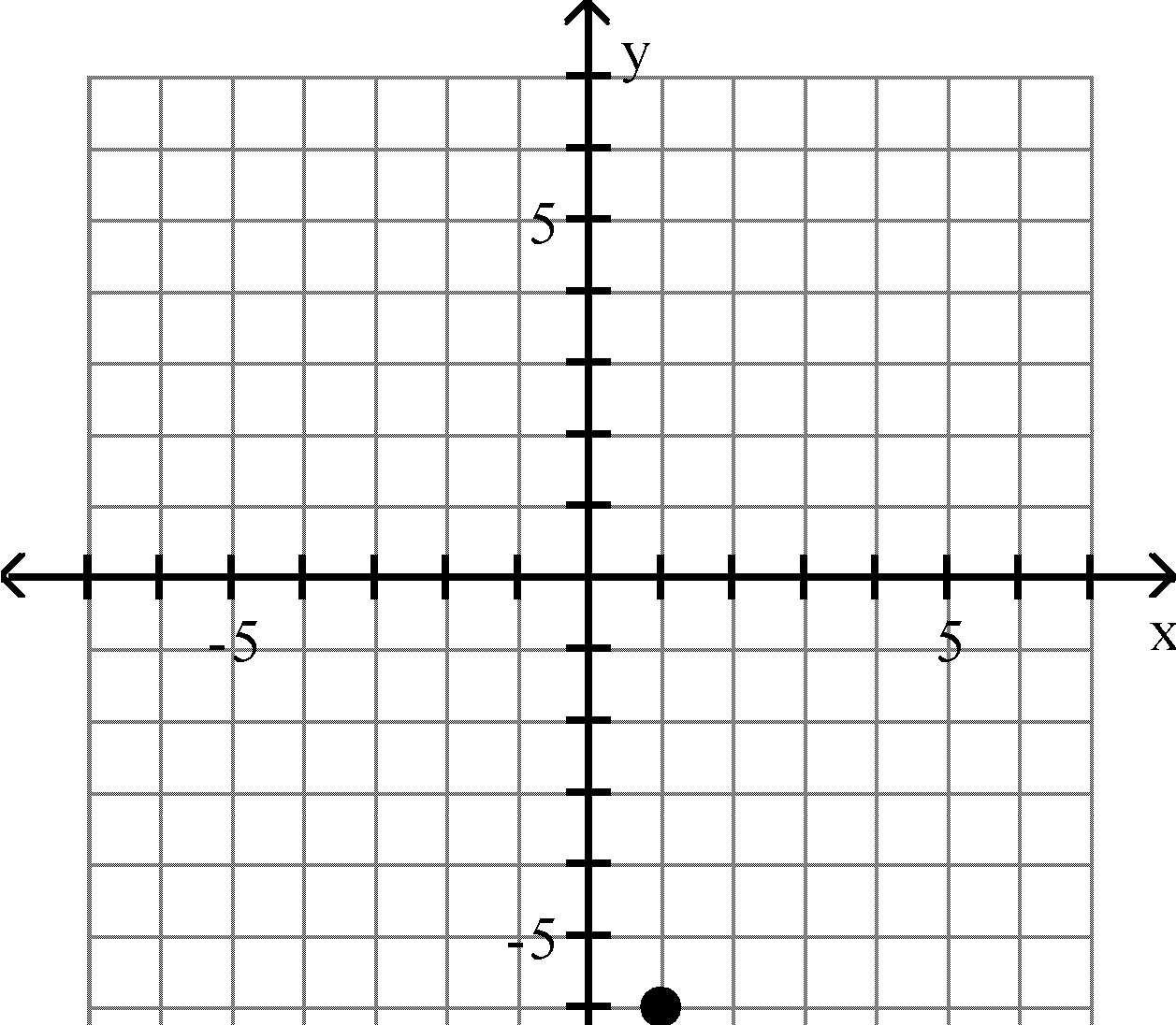

Objective: (1.1) Rectangular Coordinates 14) (-5, 2)
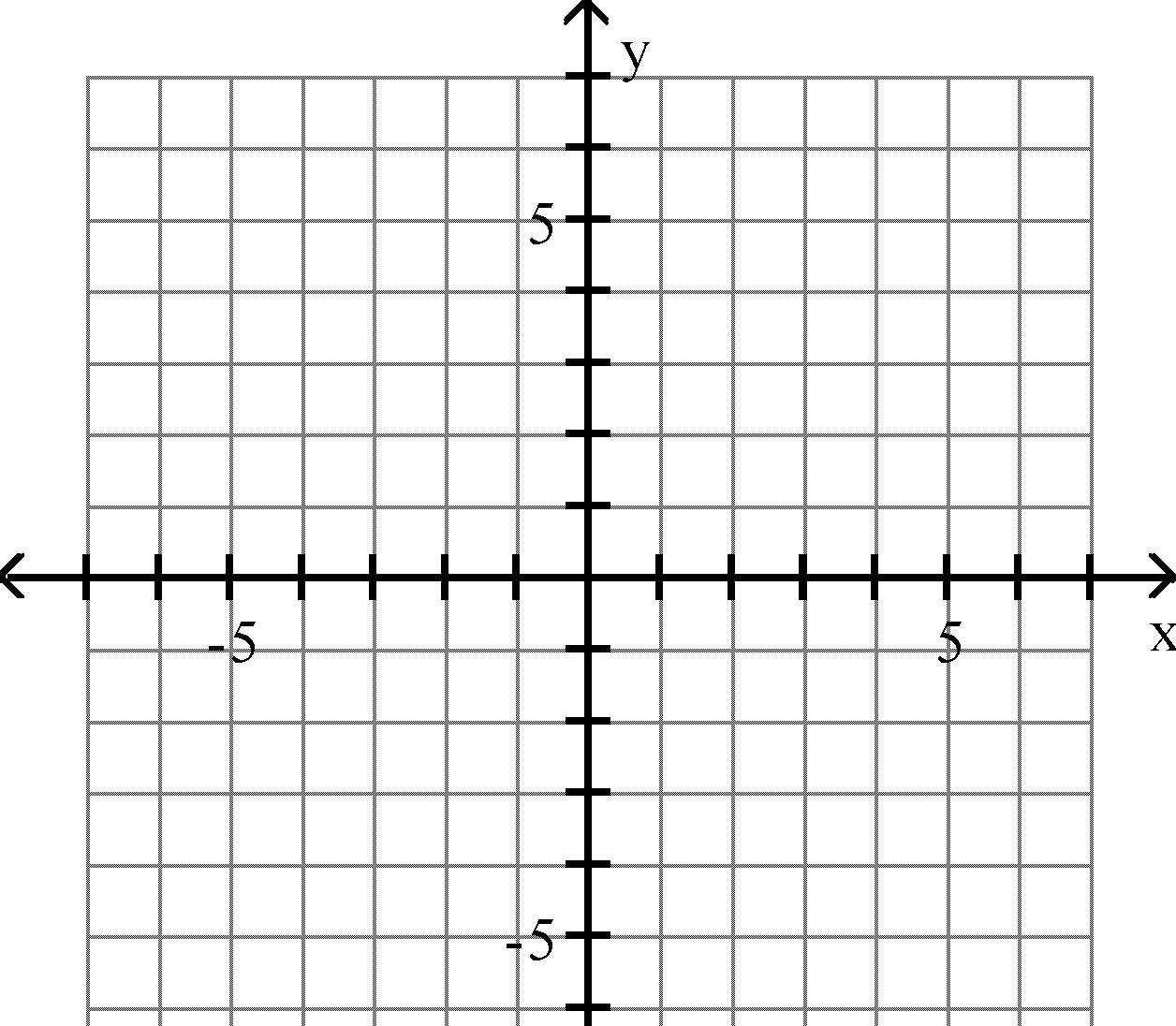




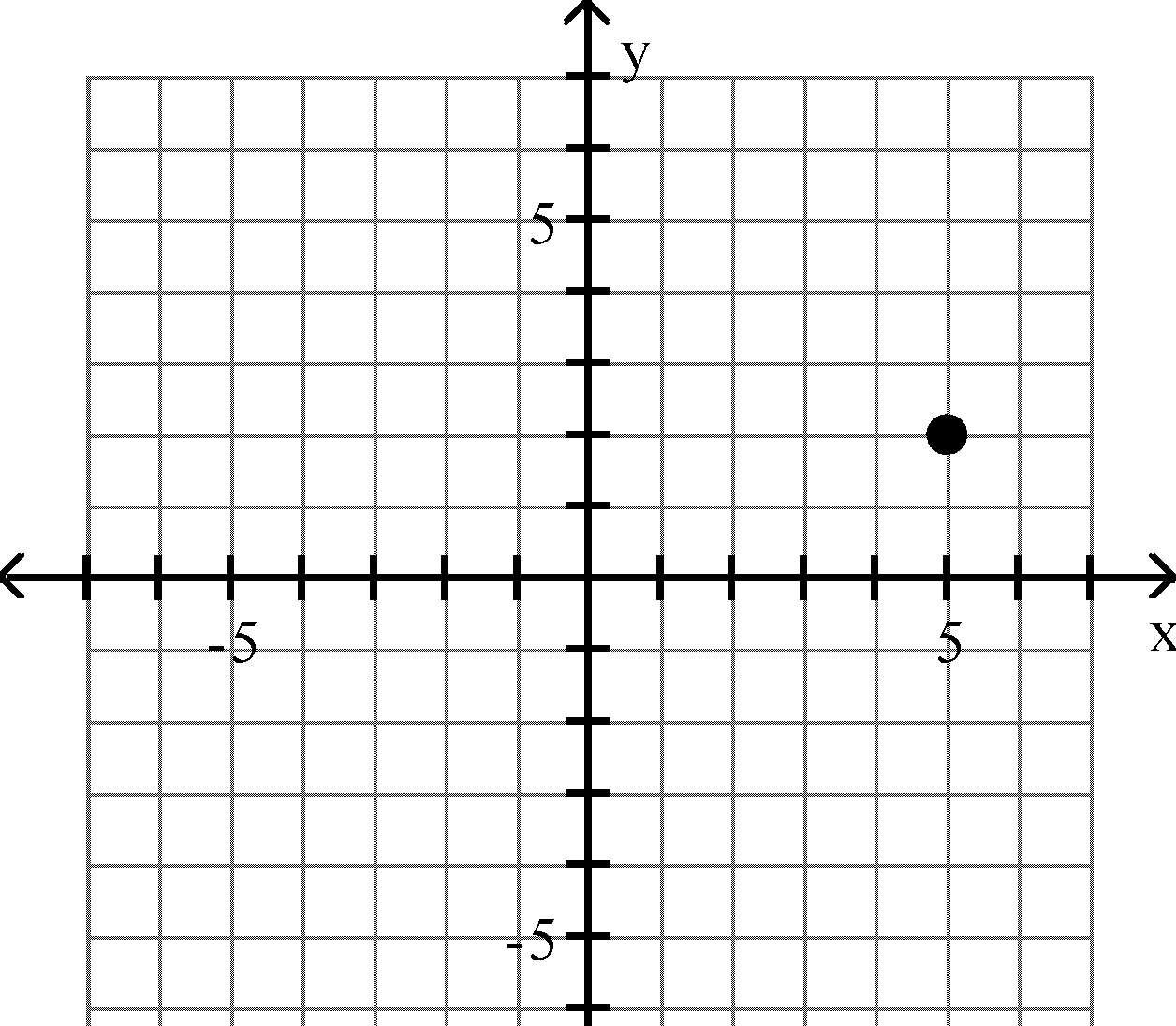


Objective: (1.1) Rectangular Coordinates
15) (2, -5)


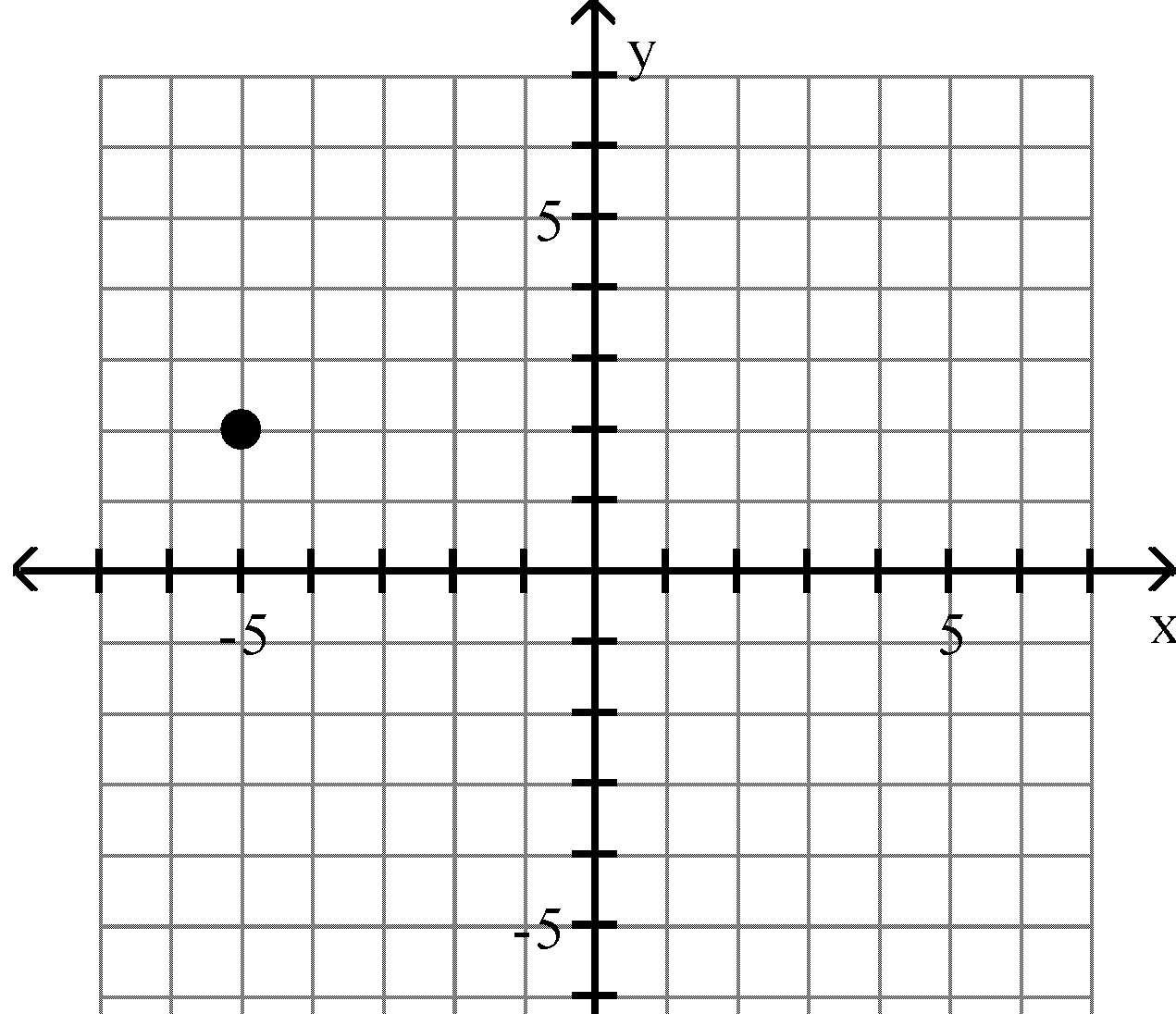

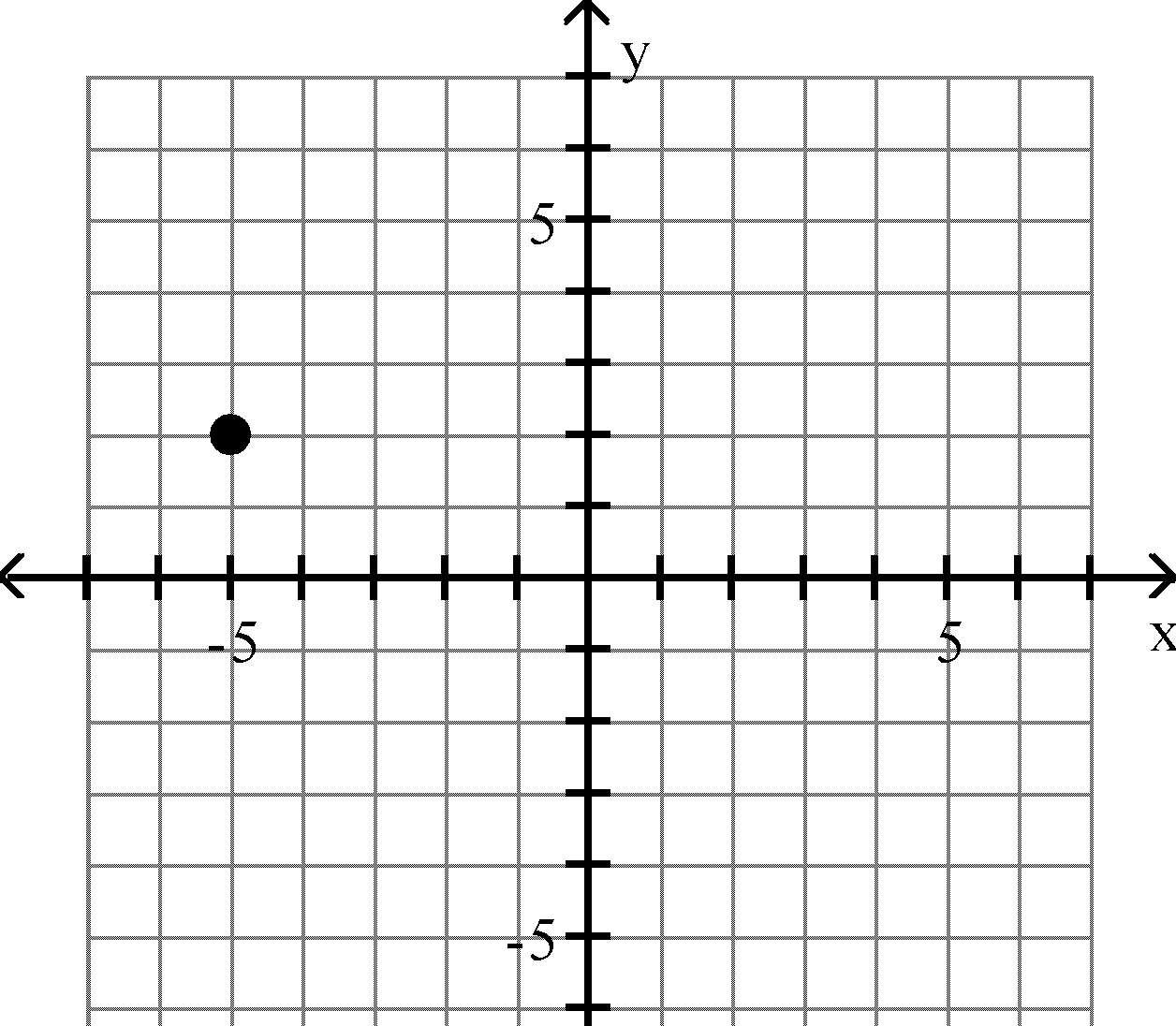
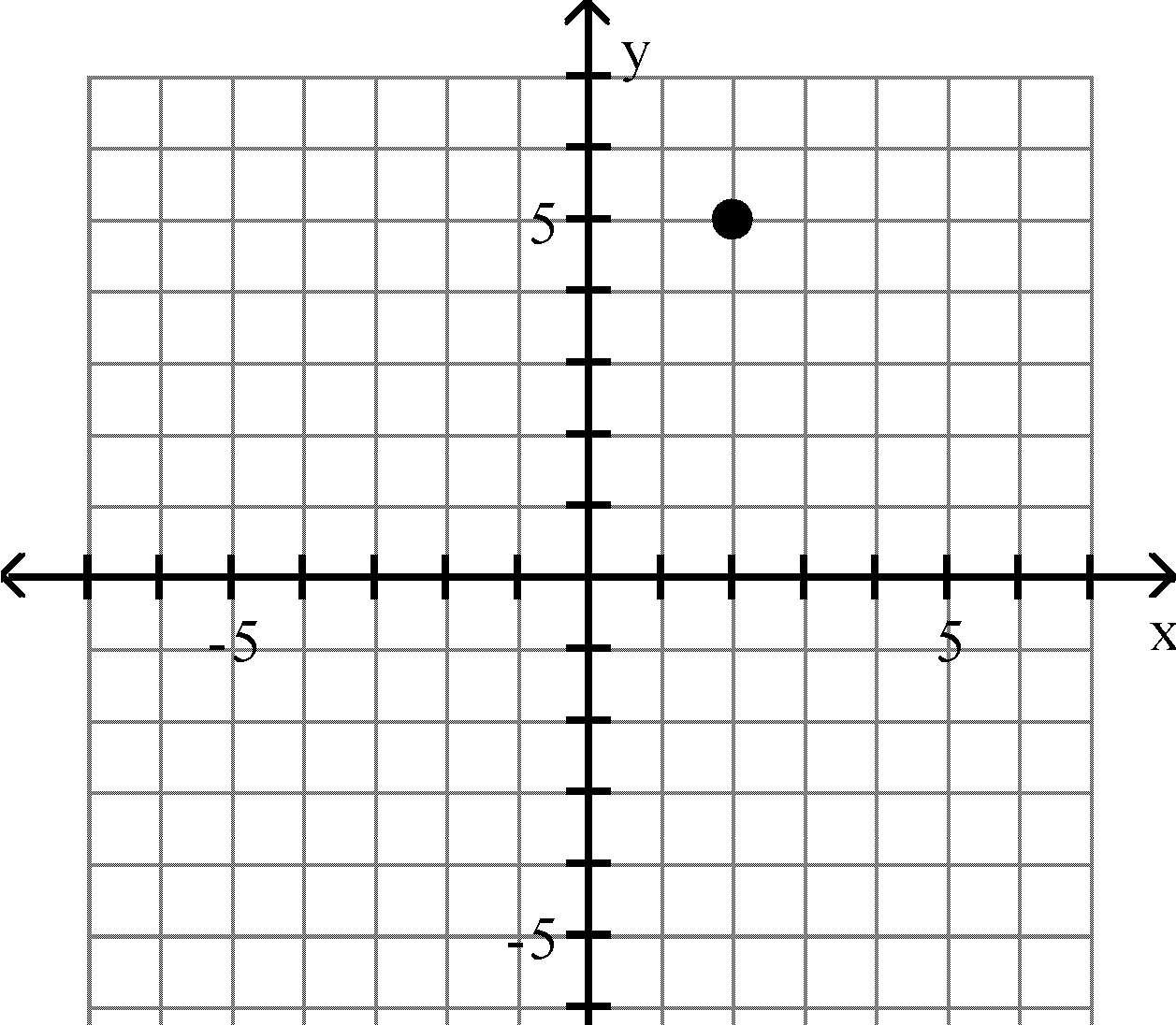

Objective: (1.1) Rectangular Coordinates
16) (-5, -3)


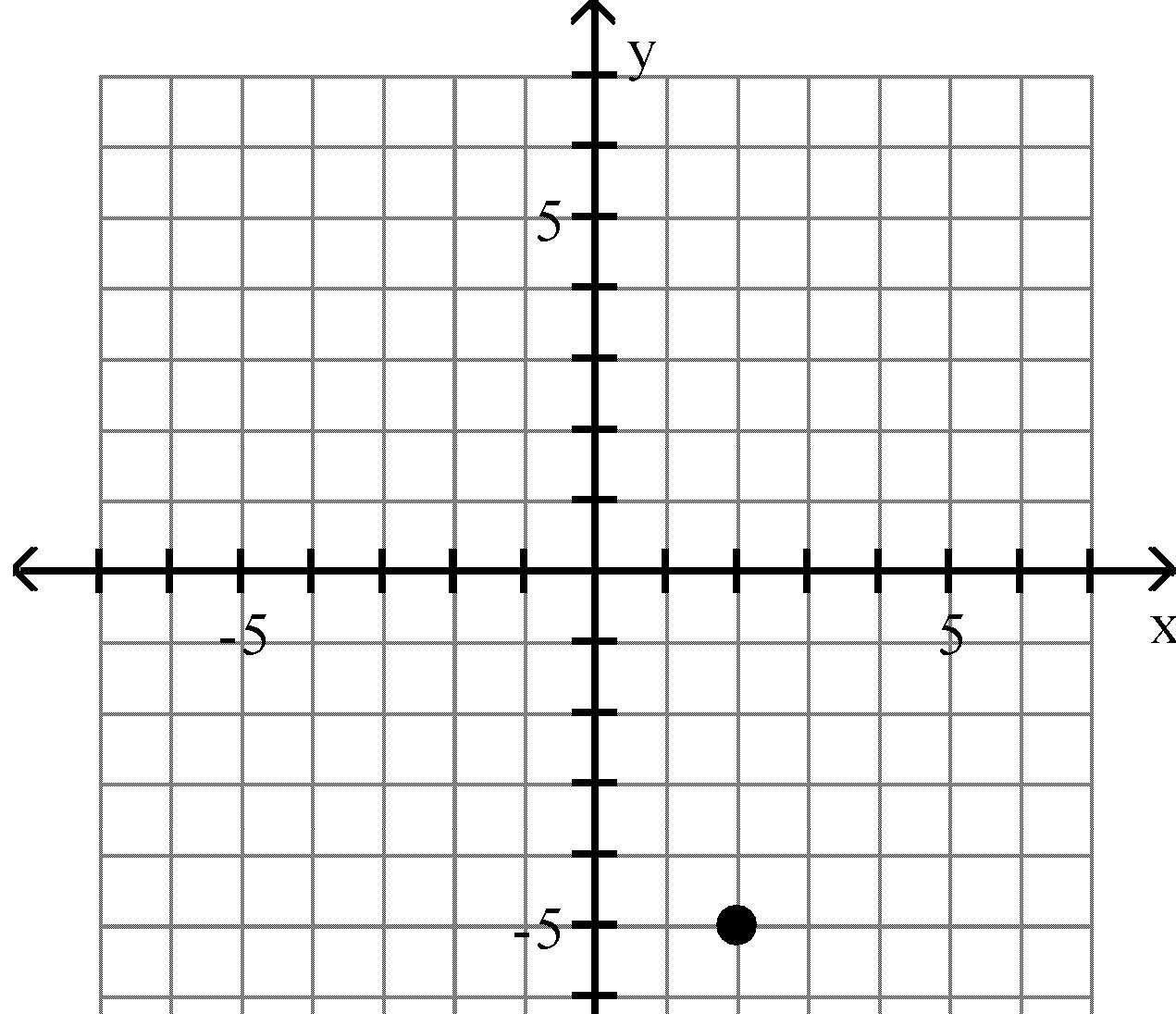


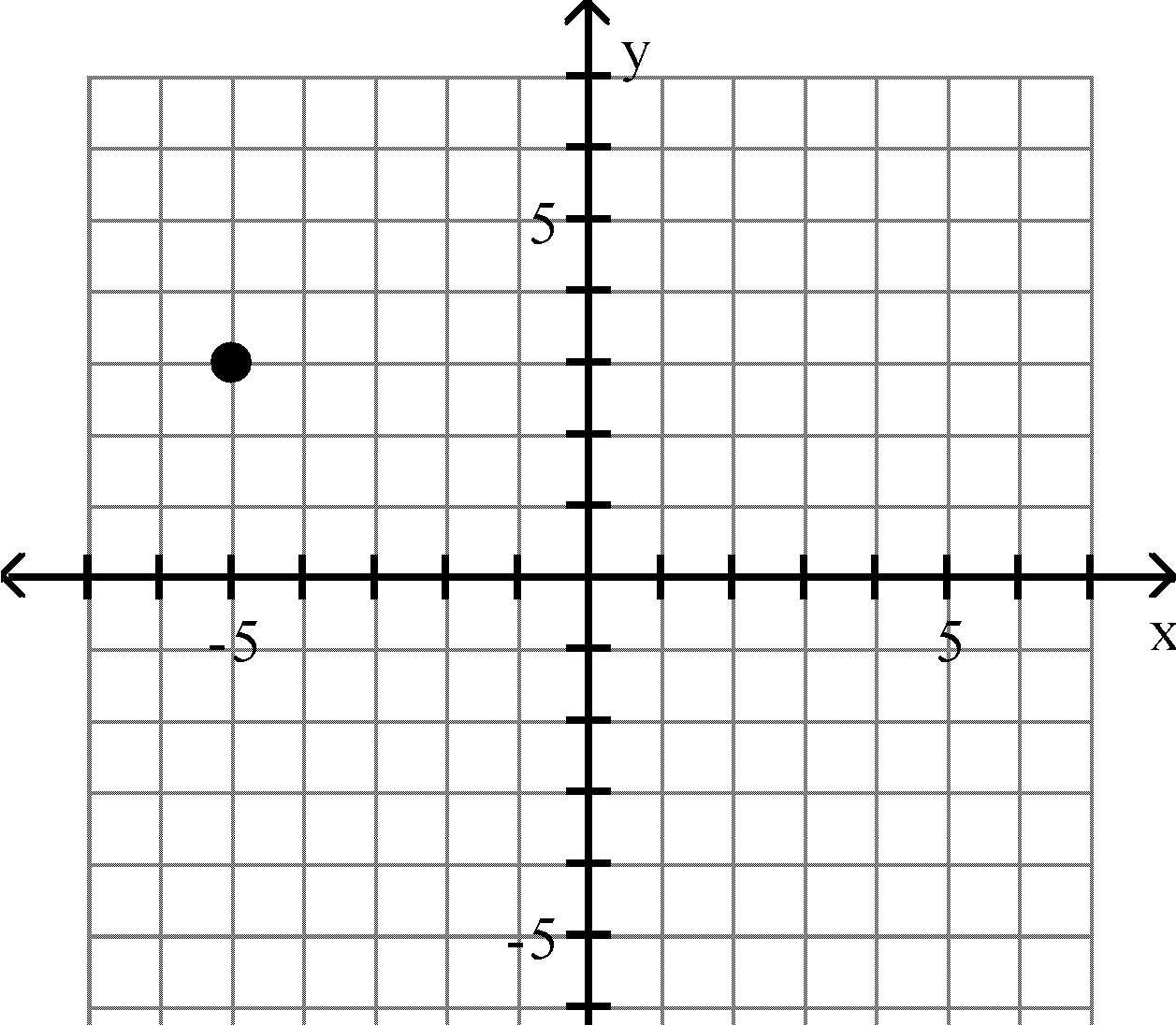

Objective: (1.1) Rectangular Coordinates
17) (0, 5)

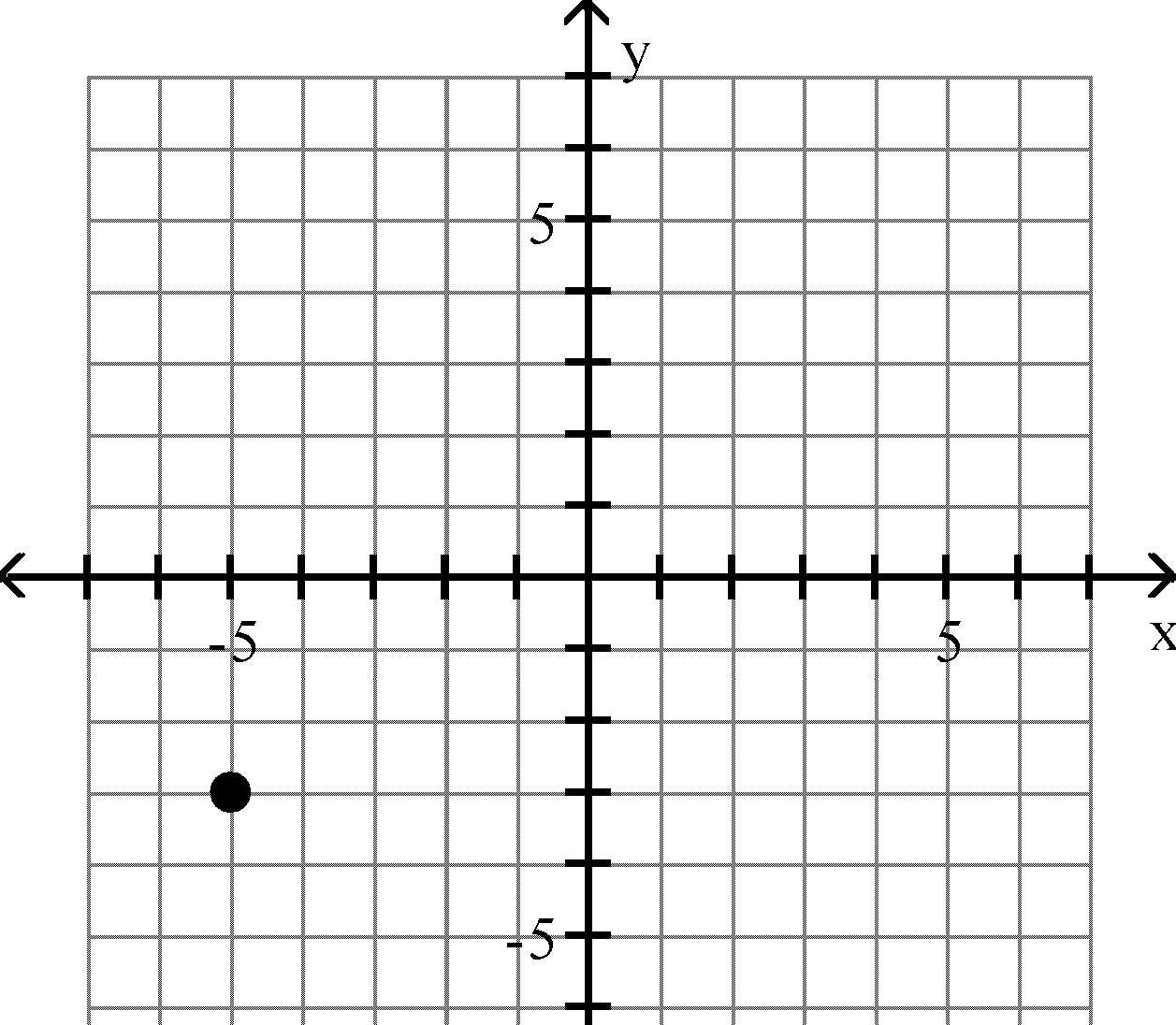
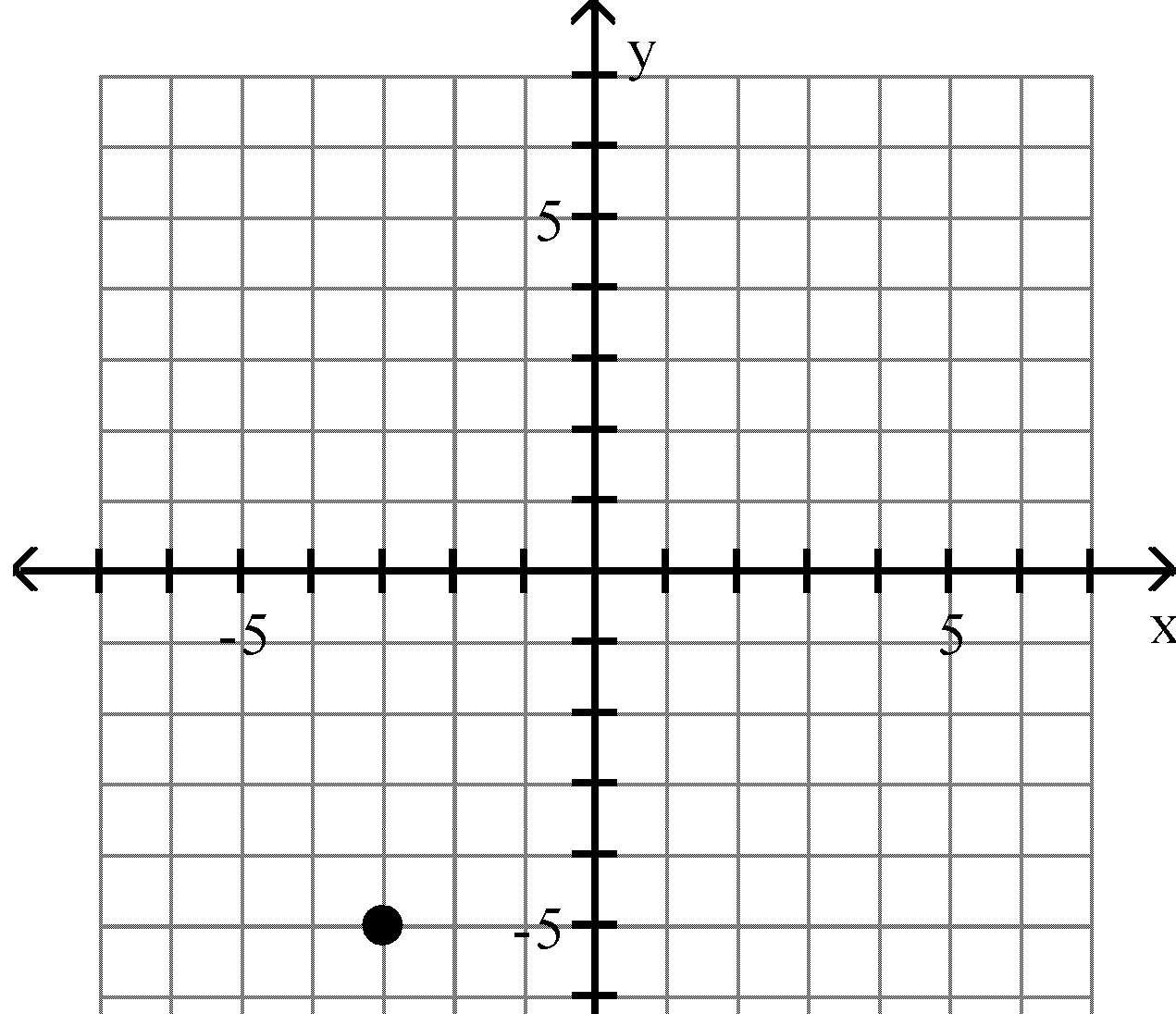


x-axis


Objective: (1.1) Rectangular Coordinates
18) (-6, 0)

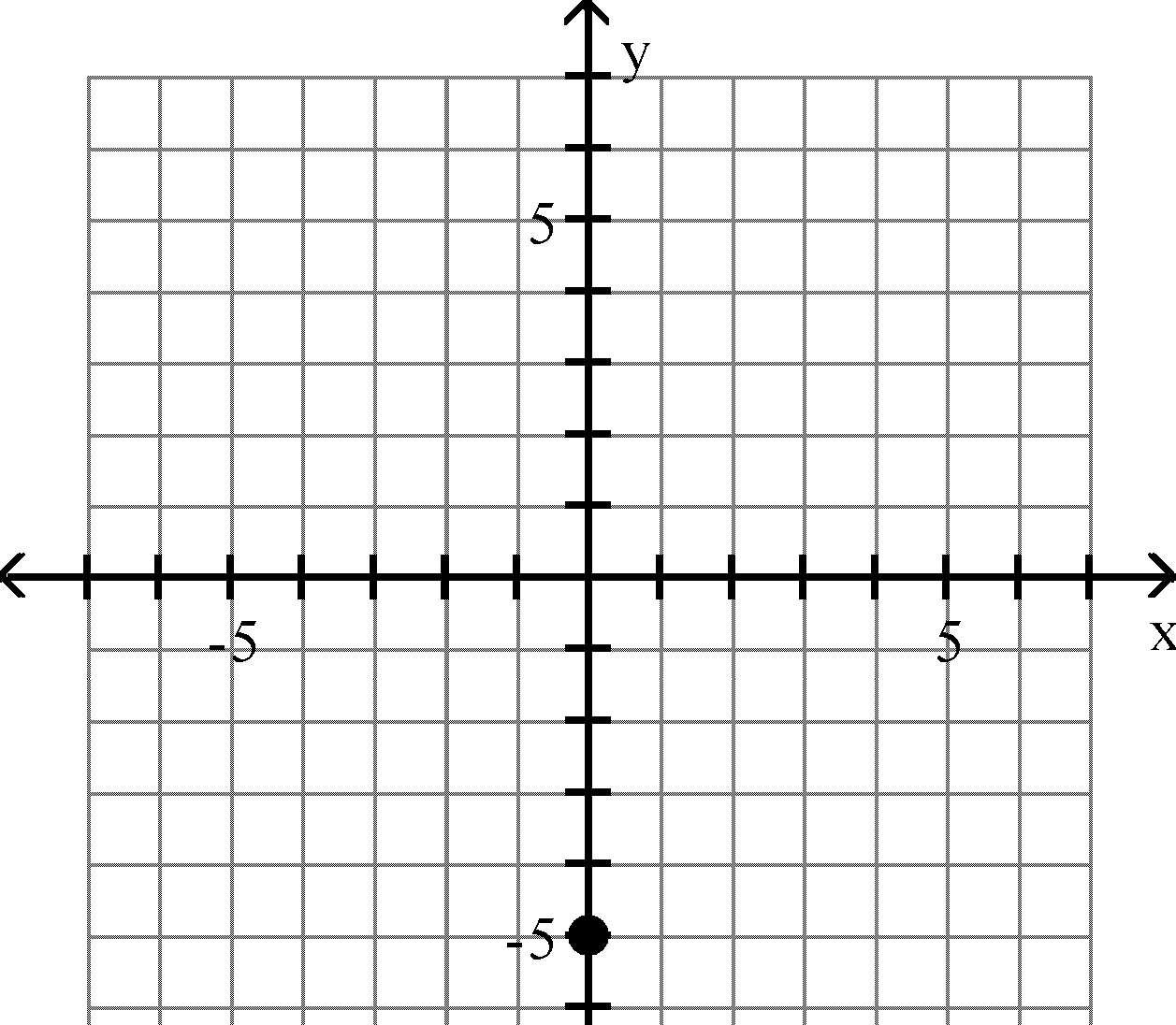
-axis
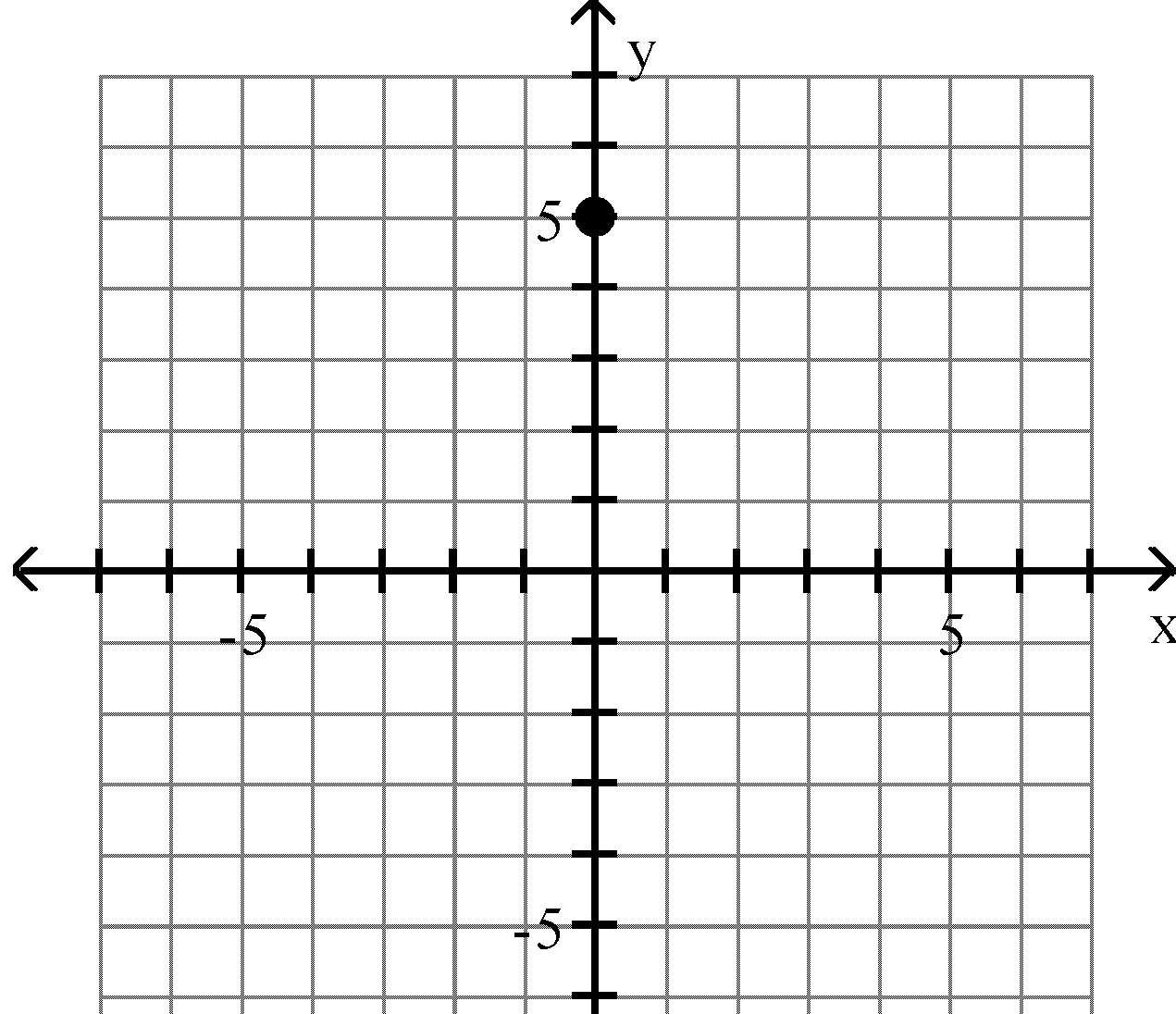


y-axis
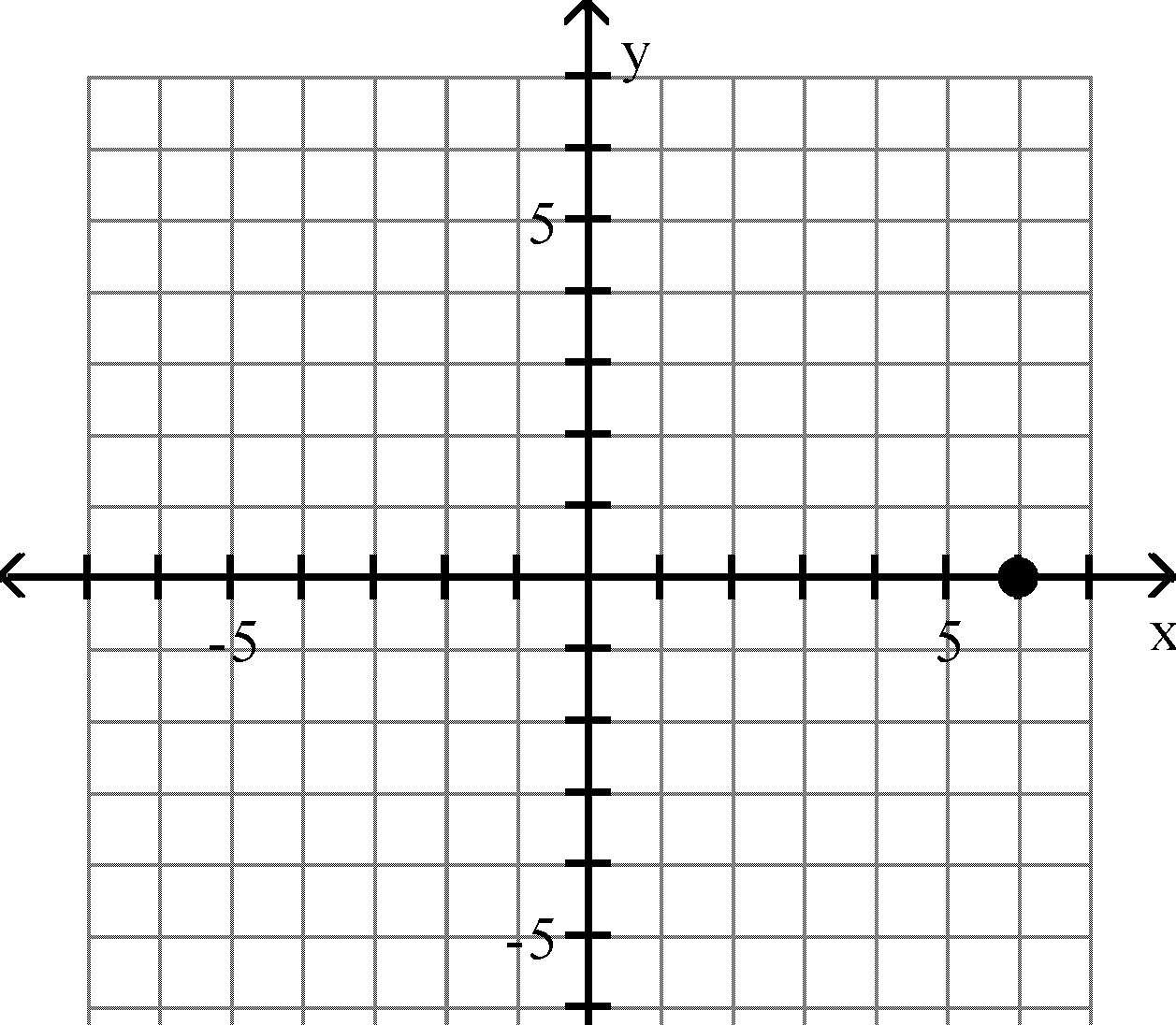
-axis C)
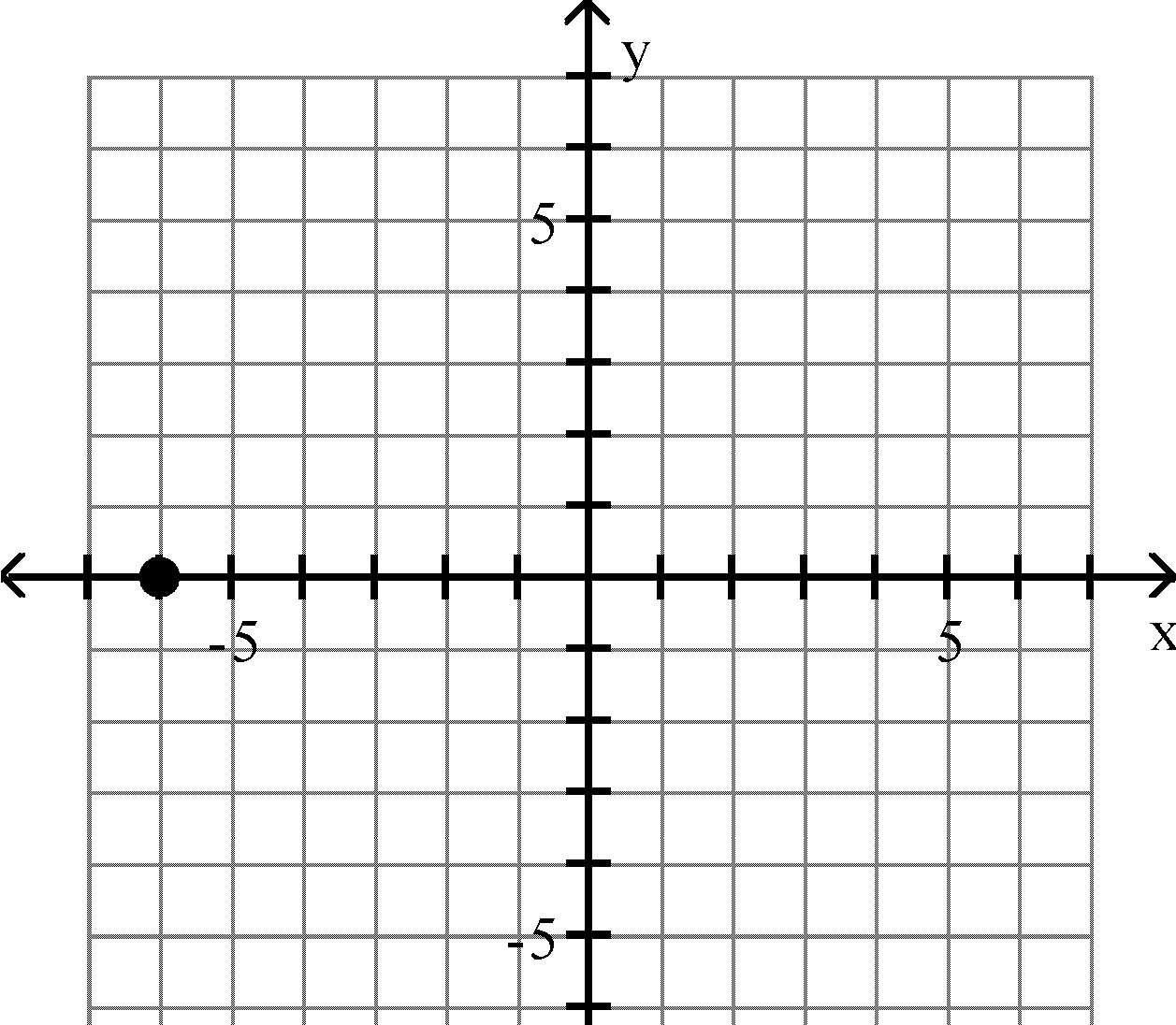

Objective: (1.1) Rectangular Coordinates
Find the distance d(P1, P2) between the points P1 and P2. 19)
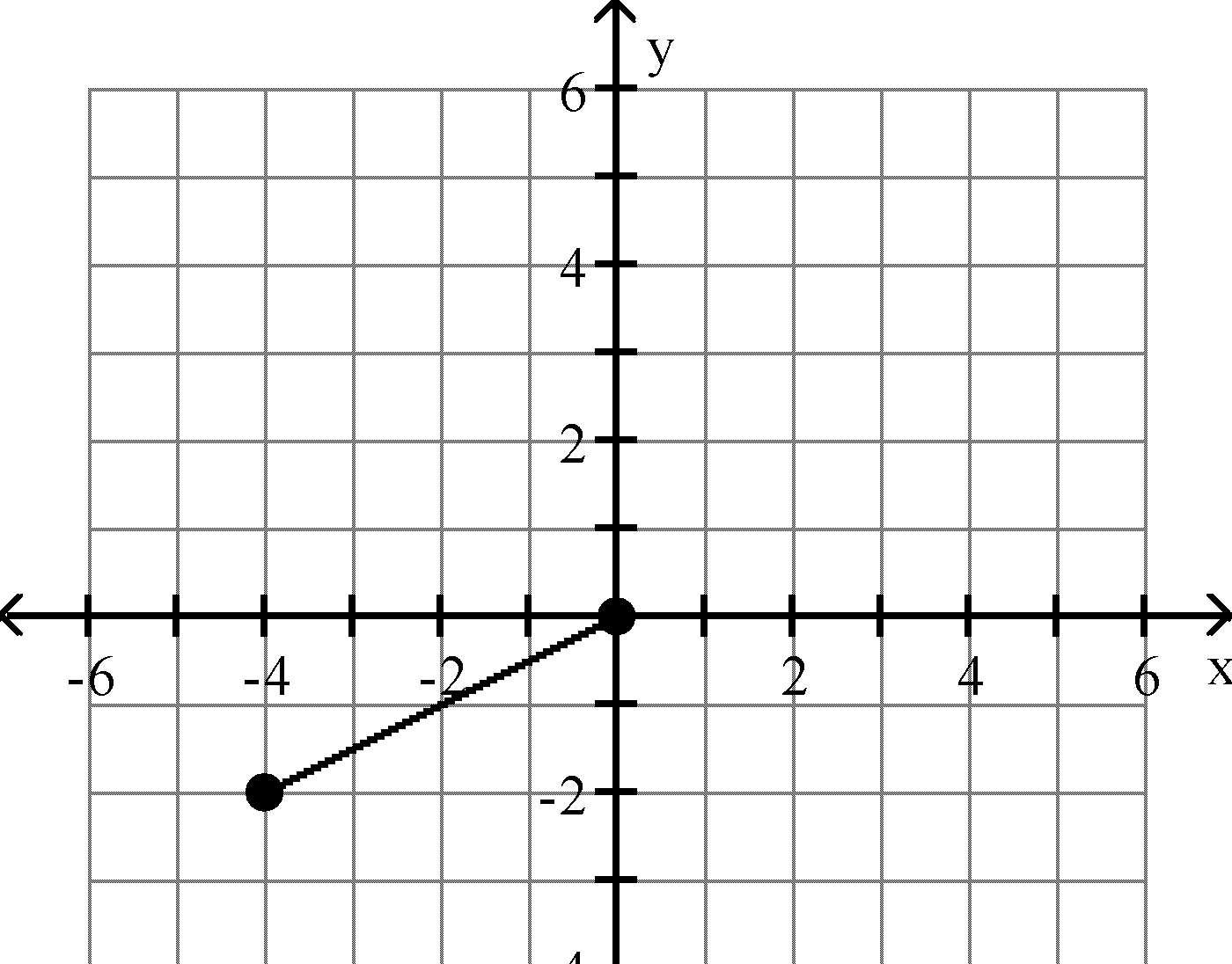

A) 1
B) 3
Objective: (1.1) Use the Distance Formula
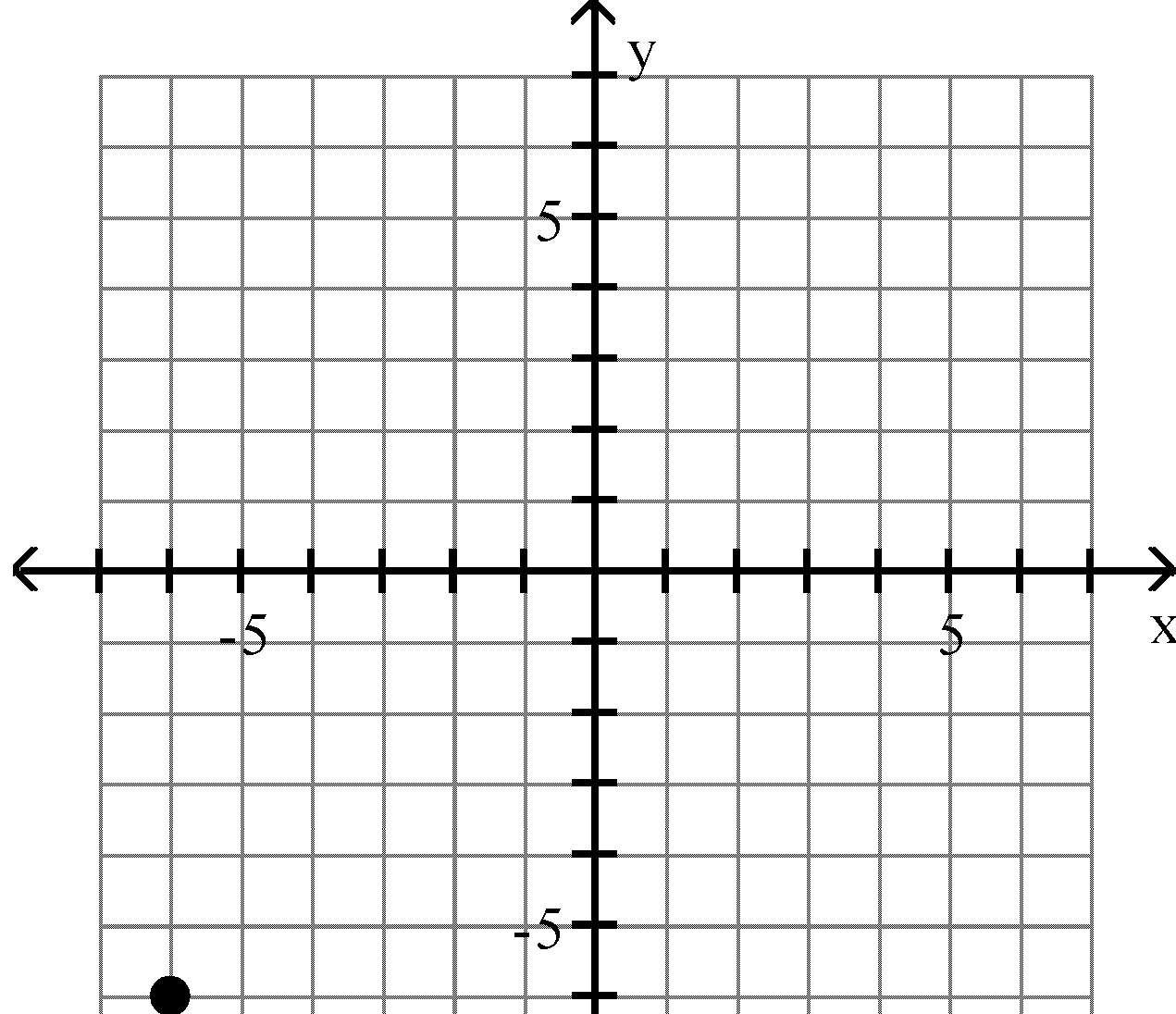

C) 2 D) 25


A) 1
B) 15
Objective: (1.1) Use the Distance Formula 21) x


A) 2
B) 123
Objective: (1.1) Use the Distance Formula
22) x


A) 48
B) 52
Objective: (1.1) Use the Distance Formula
C) 113 D) 56
C) 12 D) 25
C) 483 D) 6
23) P1 = (1, 1); P2 = (1, -1)
A) 3
B) 2 C) 1
Objective: (1.1) Use the Distance Formula
24) P1 = (3, -3); P2 = (-1, -6)
A) 10
B) 6
Objective: (1.1) Use the Distance Formula
25) P1 = (0, 8); P2 = (7, 8)
A) 7
C) 5 D) 25
B) 113 C) 49
Objective: (1.1) Use the Distance Formula
26) P1 = (0, 0); P2 = (-6, 3)
A) 35 B) 3 C) 3i2
Objective: (1.1) Use the Distance Formula
27) P1 = (6, 3); P2 = (-5, -3)
A) 157
B) 66
Objective: (1.1) Use the Distance Formula
28) P1 = (6, -7); P2 = (2, -1)
A) 20
B) 213
Objective: (1.1) Use the Distance Formula
29) P1 = (-6, -5); P2 = (4, -3)
A) 8
B) 966
Objective: (1.1) Use the Distance Formula
8
2
45
C) 85 D) 5
C) 10 D) 205
C) 226 D) 96
30) P1 = (0.1, 0.6); P2 = (1.9, 2) Round to three decimal places, if necessary.
A) 16 B) 2.38
Objective: (1.1) Use the Distance Formula
Decide whether or not the points are the vertices of a right triangle.
31) (4, -9), (7, -9), (7, -4)
A) Yes
Objective: (1.1) Use the Distance Formula
32) (9, -5), (11, -1), (13, -2)
A) Yes
Objective: (1.1) Use the Distance Formula
33) (-8, -1), (-2, 1), (-3, -4)
A) Yes
Objective: (1.1) Use the Distance Formula
C) 7.211 D) 2.28
B) No
B) No
B) No
34) (-4, 12), (2, 14), (8, 7)
A) Yes B) No
Objective: (1.1) Use the Distance Formula
Solve the problem.
35) Find all values of k so that the given points are 29 units apart. (-5, 5), (k, 0)
A) 3, 7 B) -3, -7
Objective: (1.1) Use the Distance Formula
C) -7 D) 7
36) Find the area of the right triangle ABC with A = (-2, 7), B = (7, -1), C = (3, 9).
A) 29 square units B) 58 square units C) 29 2 square units D) 58 2 square units
Objective: (1.1) Use the Distance Formula
37) Find all the points having an x-coordinate of 9 whose distance from the point (3, -2) is 10.
A) (9, 13), (9, -7)
B) (9, 6), (9, -10)
Objective: (1.1) Use the Distance Formula
C) (9, -12), (9, 8) D) (9, 2), (9, -4)
38) A middle school's baseball playing field is a square, 70 feet on a side. How far is it directly from home plate to second base (the diagonal of the square)? If necessary, round to the nearest foot.
A) 98 feet
B) 106 feet
Objective: (1.1) Use the Distance Formula
C) 99 feet
D) 100 feet
39) A motorcycle and a car leave an intersection at the same time. The motorcycle heads north at an average speed of 20 miles per hour, while the car heads east at an average speed of 48 miles per hour. Find an expression for their distance apart in miles at the end of t hours.
A) 2t13 miles B) 52t miles C) 52t miles D) t68 miles
Objective: (1.1) Use the Distance Formula
40) A rectangular city park has a jogging loop that goes along a length, width, and diagonal of the park. To the nearest yard, find the length of the jogging loop, if the length of the park is 125 yards and its width is 75 yards.
A) 346 yards B) 345 yards C) 146 yards
Objective: (1.1) Use the Distance Formula
D) 145 yards
41) Find the length of each side of the triangle determined by the three points P1, P2, and P3. State whether the triangle is an isosceles triangle, a right triangle, neither of these, or both.
P1 = (-5, -4), P2 = (-3, 4), P3 = (0, -1)
A) d(P1, P2) = 217; d(P2, P3) = 34; d(P1, P3) = 52 neither
B) d(P1, P2) = 217; d(P2, P3) = 34; d(P1, P3) = 34 both
C) d(P1, P2) = 217; d(P2, P3) = 34; d(P1, P3) = 52 right triangle
D) d(P1, P2) = 217; d(P2, P3) = 34; d(P1, P3) = 34 isosceles triangle
Objective: (1.1) Use the Distance Formula
Find the midpoint of the line segment joining the points P1 and P2.
42) P1 = (5, 9); P2 = (8, 3)
A) (6, 13 2 ) B) (-3, 6)
Objective: (1.1) Use the Midpoint Formula
43) P1 = (-3, 1); P2 = (-4, 5)
A)7 2 , 3 B) -7, 6
Objective: (1.1) Use the Midpoint Formula
44) P1 = (7, 1); P2 = (-16, -16)
C) (13 2 , 6)
D) (13, 12)
1 2 , - 2
1, -4
A) -9, -15 B) 23 2 , 17 2 C)9 2 ,15 2 D) 9, 15
Objective: (1.1) Use the Midpoint Formula
45) P1 = (0.7, -0.3); P2 = (2.2, -1.9) A) (-1.1, 1.45) B) (-0.8, 0.75) C) (0.75, -0.8) D) (1.45, -1.1)
Objective: (1.1) Use the Midpoint Formula
46) P1 = (x, 8); P2 = (0, 3)
A) x, 11 B) x, 11 2 C) x 2 , 11 2
Objective: (1.1) Use the Midpoint Formula
47) P1 = (8a, 6); P2 = (9a, 9)
A) 17a 2 , 15 2
B) 15a 2 , 17 2
Objective: (1.1) Use the Midpoint Formula
Solve the problem.
C) 17a, 15
48) If (-3, 1) is the endpoint of a line segment, and (1, 6) is its midpoint, find the other endpoint. A) (7, 9)
B) (-11, -9)
Objective: (1.1) Use the Midpoint Formula
C) (5, 11)
x 2 , 5
D) a, 3
D) (5, -4)
49) If (-1, -4) is the endpoint of a line segment, and (-5, -6) is its midpoint, find the other endpoint.
A) (7, 0)
B) (-5, -12)
Objective: (1.1) Use the Midpoint Formula
C) (-9, -2)
50) If (-2, 7) is the endpoint of a line segment, and (2, 6) is its midpoint, find the other endpoint. A) (6, 8)
B) (-4, 15)
Objective: (1.1) Use the Midpoint Formula
C) (-10, 9)
D) (-9, -8)
D) (6, 5)
51) If (-10, 1) is the endpoint of a line segment, and (-13, 6) is its midpoint, find the other endpoint.
A) (-4, -9)
B) (0, -5)
Objective: (1.1) Use the Midpoint Formula
C) (-16, -4)
D) (-16, 11)
52) The medians of a triangle intersect at a point. The distance from the vertex to the point is exactly two-thirds of the distance from the vertex to the midpoint of the opposite side. Find the exact distance of that point from the vertex A(3, 4) of a triangle, given that the other two vertices are at (0, 0) and (8, 0).
A) 17 3 B) 217 3 C) 2 D) 8 3
Objective: (1.1) Use the Midpoint Formula
Determine whether the given point is on the graph of the equation.
53) Equation: y = x4 - x
Point: (-1, 0)
A) Yes
Objective: (1.2) Graph Equations by Plotting Points
54) Equation: x2 - y2 = 16 Point: (0, 4)
A) Yes
Objective: (1.2) Graph Equations by Plotting Points
Graph the equation by plotting points.
55) y = x + 2
B) No
B) No
Objective: (1.2) Graph Equations by Plotting Points
56) y = 2x + 6
Objective: (1.2) Graph Equations by Plotting Points 57) y = -x2 + 4
Objective: (1.2) Graph Equations by Plotting Points
58) 3x + 5y = 15
Objective: (1.2) Graph Equations by Plotting Points
59) 4x2 + 9y = 36
Objective: (1.2) Graph Equations by Plotting Points
Solve the problem.
60) If (a, 3) is a point on the graph of y = 2x - 5, what is a?
A) 1 B) -4
Objective: (1.2) Graph Equations by Plotting Points
61) If (3, b) is a point on the graph of 3x - 2y = 17, what is b?
23 3
-4
Objective: (1.2) Graph Equations by Plotting Points
4
-1
4
11 3
62) The height of a baseball (in feet) at time t (in seconds) is given by y = -16x2 + 80x + 5. Which one of the following points is not on the graph of the equation?
A) (2, 117)
B) (1, 69)
Objective: (1.2) Graph Equations by Plotting Points
List the intercepts of the graph. 63)
C) (4, 69)
D) (3, 101)
A) (0, -3), (3, 0)
B) (-3, 0), (0, 3)
Objective: (1.2) Find Intercepts from a Graph
C) (0, -3), (0, 3)
D) (-3, 0), (3, 0)
A) (0, 0)
B) (-1, 0)
Objective: (1.2) Find Intercepts from a Graph
C) (0, -1)
D) (-1, -1)
A)π 2 , 0 , (4, 0), π 2 , 0
B)π 2 , 0 , (0, 4), π 2 , 0
C) 0,π 2 , (0, 4), 0, π 2 D) 0,π 2 , (4, 0), 0, π 2
Objective: (1.2) Find Intercepts from a Graph
x-10-5510
A) (-2, 0), (0, 8), (4, 0) B) (0, -2), (0, 8), (4, 0) C) (0, -2), (8, 0), (0, 4) D) (-2, 0), (0, 8), (0, 4)
Objective: (1.2) Find Intercepts from a Graph
x-10-5510
A) (-3, 0)
B) (3, 0)
Objective: (1.2) Find Intercepts from a Graph
68) x-10-5510 y 10 5 -5
A) (-6, 0), (0, -6), (0, 0), (0, 6), (6, 0)
C) (0, 3)
D) (0, -3)
B) (-6, 0), (0, -6), (0, 6), (6, 0)
C) (0, 6), (6, 0) D) (-6, 0), (0, 6)
Objective: (1.2) Find Intercepts from a Graph
A) (-2, 0), (1, 0) (-5, 0), (0, -2)
C) (-2, 0), (0, -2), (0, 1), (0, -5)
Objective: (1.2) Find Intercepts from a Graph
70)

A) (-2, 0), (2, 0)
B) (-2, 0), (0, 4), (2, 0)
Objective: (1.2) Find Intercepts from a Graph
List the intercepts for the graph of the equation.
71) y = x - 5
A) (5, 0), (0, 5)
B) (-5, 0), (0, -5)
Objective: (1.2) Find Intercepts from an Equation
72) y = 5x
A) (0, 0)
B) (5, 0)
Objective: (1.2) Find Intercepts from an Equation
73) y2 = x + 36
A) (-6, 0), (0, -36), (6, 0)
C) (0, -6), (-36, 0), (0, 6)
Objective: (1.2) Find Intercepts from an Equation
B) (-2, 0), (0, 2), (0, 1), (0, 5)
D) (2, 0), (1, 0), (5, 0), (0, -2)
C) (-2, 0), (0, 2), (2, 0)
D) (-4, 0), (0, 4), (4, 0)
C) (5, 0), (0, -5)
D) (-5, 0), (0, 5)
C) (0, 5)
B) (6, 0), (0, 36), (0, -36)
D) (0, -6), (36, 0), (0, 6)
D) (5, 5)
74) y = 3 x
A) (0, 1)
B) (1, 1)
Objective: (1.2) Find Intercepts from an Equation
75) x2 + y - 9 = 0
A) (-3, 0), (0, 9), (3, 0)
B) (0, -3), (9, 0), (0, 3)
Objective: (1.2) Find Intercepts from an Equation
76) 4x2 + 16y2 = 64
A) (-2, 0), (-4, 0), (4, 0), (2, 0)
C) (-16, 0), (0, -4), (0, 4), (16, 0)
Objective: (1.2) Find Intercepts from an Equation
77) 4x2 + y2 = 4
A) (-1, 0), (0, -2), (0, 2), (1, 0)
C) (-2, 0), (0, -1), (0, 1), (2, 0)
Objective: (1.2) Find Intercepts from an Equation
78) y = x3 - 27
A) (0, -3), (-3, 0)
B) (-27, 0), (0, 3)
Objective: (1.2) Find Intercepts from an Equation
79) y = x4 - 16
A) (0, 16)
C) (0, 16), (-2, 0), (2, 0)
Objective: (1.2) Find Intercepts from an Equation
80) y = x2 + 6x + 9
A) (0, 3), (0, 3), (9, 0)
B) (0, -3), (0, -3), (9, 0)
Objective: (1.2) Find Intercepts from an Equation
81) y = x2 + 4
A) (4, 0), (0, -2), (0, 2) B) (4, 0)
Objective: (1.2) Find Intercepts from an Equation
82) y = 4x x2 + 16
A) (-16, 0), (0, 0), (16, 0)
C) (1, 0)
D) (0, 0)
C) (3, 0), (0, 9), (0, -9)
D) (-3, 0), (0, -9), (3, 0)
B) (-4, 0), (-16, 0), (16, 0), (4, 0)
D) (-4, 0), (0, -2), (0, 2), (4, 0)
B) (-4, 0), (0, -1), (0, 1), (4, 0)
D) (-1, 0), (0, -4), (0, 4), (1, 0)
C) (0, -3), (0, 3) D) (0, -27), (3, 0)
B) (0, -16), (-2, 0), (2, 0)
D) (0, -16)
C) (3, 0), (3, 0), (0, 9) D) (-3, 0), (-3, 0), (0, 9)
C) (0, 4)
B) (-4, 0), (0, 0), (4, 0) C) (0, -4), (0, 0), (0, 4) D) (0, 0)
Objective: (1.2) Find Intercepts from an Equation
83) y = x2 - 16 4x4
A) (0, 0)
C) (-4, 0), (4, 0)
Objective: (1.2) Find Intercepts from an Equation
B) (-16, 0), (0, 0), (16, 0)
D) (0, -4), (0, 4)
D) (0, 4), (-2, 0), (2, 0)
Plot the point A. Plot the point B that has the given symmetry with point A. 84) A = (-4, 2); B is symmetric to A with respect to the x-axis x -5-4-3-2-112345
Objective: (1.2) Test an Equation for Symmetry with Respect to the x-Axis, the y-Axis, and the Origin
85) A = (0, -3); B is symmetric to A with respect to the origin
Objective: (1.2) Test an Equation for Symmetry with Respect to the x-Axis, the y-Axis, and the Origin
List the intercepts of the graph.Tell whether the graph is symmetric with respect to the x-axis, y-axis, origin, or none of these. 86)
A) intercepts: (0, -1) and (0, 1) symmetric with respect to x-axis, y-axis, and origin
B) intercepts: (0, -1) and (0, 1) symmetric with respect to y-axis
C) intercepts: (-1, 0) and (1, 0) symmetric with respect to x-axis, y-axis, and origin
D) intercepts: (-1, 0) and (1, 0) symmetric with respect to origin
Objective: (1.2) Test an Equation for Symmetry with Respect to the x-Axis, the y-Axis, and the Origin 87)
A) intercepts: (3, 0) and (-3, 0 symmetric with respect to y-axis
B) intercepts: (3, 0) and (-3, 0) symmetric with respect to x-axis, y-axis, and origin
C) intercepts: (0, 3) and (0, -3) symmetric with respect to x-axis, y-axis, and origin
D) intercepts: (0, 3) and (0, -3) symmetric with respect to origin
Objective: (1.2) Test an Equation for Symmetry with Respect to the x-Axis, the y-Axis, and the Origin
A) intercept: (0, 4) no symmetry
C) intercept: (4, 0) symmetric with respect to y-axis
B) intercept: (0, 4) symmetric with respect to x-axis
D) intercept: (4, 0) no symmetry
Objective: (1.2) Test an Equation for Symmetry with Respect to the x-Axis, the y-Axis, and the Origin
A) intercept: (3, 0) symmetric with respect to y-axis
C) intercept: (0, 3) symmetric with respect to y-axis
B) intercept: (3, 0) symmetric with respect to x-axis
D) intercept: (0, 3) symmetric with respect to origin
Objective: (1.2) Test an Equation for Symmetry with Respect to the x-Axis, the y-Axis, and the Origin
A) intercepts: (-2, 0), (0, 0), (2, 0) symmetric with respect to x-axis, y-axis, and origin
B) intercepts: (-2, 0), (0, 0), (2, 0) symmetric with respect to x-axis
C) intercepts: (-2, 0), (0, 0), (2, 0) symmetric with respect to origin
D) intercepts: (-2, 0), (0, 0), (2, 0) symmetric with respect to y-axis
Objective: (1.2) Test an Equation for Symmetry with Respect to the x-Axis, the y-Axis, and the Origin
Draw a complete graph so that it has the given type of symmetry. 91) Symmetric with respect to the y-axis
Objective: (1.2) Test an Equation for Symmetry with Respect to the x-Axis, the y-Axis, and the Origin
92) origin
Objective: (1.2) Test an Equation for Symmetry with Respect to the x-Axis, the y-Axis, and the Origin
93) Symmetric with respect to the x-axis
Objective: (1.2) Test an Equation for Symmetry with Respect to the x-Axis, the y-Axis, and the Origin
List the intercepts and type(s) of symmetry, if any.
94) y2 = x + 4
A) intercepts: (0, -4), (2, 0), (-2, 0) symmetric with respect to y-axis
C) intercepts: (4, 0), (0, 2), (0, -2) symmetric with respect to x-axis
B) intercepts: (-4, 0), (0, 2), (0, -2) symmetric with respect to x-axis
D) intercepts: (0, 4), (2, 0), (-2, 0) symmetric with respect to y-axis
Objective: (1.2) Test an Equation for Symmetry with Respect to the x-Axis, the y-Axis, and the Origin
95) 9x2 + 4y2 = 36
A) intercepts: (2, 0), (-2, 0), (0, 3), (0, -3) symmetric with respect to x-axis, y-axis, and origin
B) intercepts: (3, 0), (-3, 0), (0, 2), (0, -2) symmetric with respect to x-axis and y-axis
C) intercepts: (3, 0), (-3, 0), (0, 2), (0, -2) symmetric with respect to the origin
D) intercepts: (2, 0), (-2, 0), (0, 3), (0, -3) symmetric with respect to x-axis and y-axis
Objective: (1.2) Test an Equation for Symmetry with Respect to the x-Axis, the y-Axis, and the Origin
96) y = -x x2 - 1
A) intercepts: (1, 0), (-1, 0), (0, 0) symmetric with respect to origin
C) intercept: (0, 0) symmetric with respect to x-axis
B) intercept: (0, 0) symmetric with respect to origin
D) intercept: (0, 0) symmetric with respect to y-axis
Objective: (1.2) Test an Equation for Symmetry with Respect to the x-Axis, the y-Axis, and the Origin
Determine whether the graph of the equation is symmetric with respect to the x-axis, the y-axis, and/or the origin.
97) y = x - 5
A) y-axis
B) x-axis
C) origin
D) x-axis, y-axis, origin
E) none
Objective: (1.2) Test an Equation for Symmetry with Respect to the x-Axis, the y-Axis, and the Origin
98) y = -3x
A) y-axis
B) origin
C) x-axis
D) x-axis, y-axis, origin
E) none
Objective: (1.2) Test an Equation for Symmetry with Respect to the x-Axis, the y-Axis, and the Origin
99) x2 + y - 64 = 0
A) x-axis
B) y-axis
C) origin
D) x-axis, y-axis, origin
E) none
Objective: (1.2) Test an Equation for Symmetry with Respect to the x-Axis, the y-Axis, and the Origin
100) y2 - x - 1 = 0
A) y-axis
B) origin
C) x-axis
D) x-axis, y-axis, origin
E) none
Objective: (1.2) Test an Equation for Symmetry with Respect to the x-Axis, the y-Axis, and the Origin
101) 4x2 + 9y2 = 36
A) y-axis
B) x-axis
C) origin
D) x-axis, y-axis, origin
E) none
Objective: (1.2) Test an Equation for Symmetry with Respect to the x-Axis, the y-Axis, and the Origin
102) 4x2 + y2 = 4
A) y-axis
B) origin
C) x-axis
D) x-axis, y-axis, origin
E) none
Objective: (1.2) Test an Equation for Symmetry with Respect to the x-Axis, the y-Axis, and the Origin
103) y = x2 + 9x + 14
A) origin
B) y-axis
C) x-axis
D) x-axis, y-axis, origin
E) none
Objective: (1.2) Test an Equation for Symmetry with Respect to the x-Axis, the y-Axis, and the Origin
104) y = 9x
x2 + 81
A) x-axis
B) y-axis
C) origin
D) x-axis, y-axis, origin
E) none
Objective: (1.2) Test an Equation for Symmetry with Respect to the x-Axis, the y-Axis, and the Origin
105) y = x2 - 9 3x4
A) origin
B) y-axis
C) x-axis
D) x-axis, y-axis, origin
E) none
Objective: (1.2) Test an Equation for Symmetry with Respect to the x-Axis, the y-Axis, and the Origin
106) y = 2x2 - 2
A) origin
B) x-axis
C) y-axis
D) x-axis, y-axis, origin
E) none
Objective: (1.2) Test an Equation for Symmetry with Respect to the x-Axis, the y-Axis, and the Origin
107) y = (x + 4)(x - 3)
A) y-axis
B) x-axis
C) origin
D) x-axis, y-axis, origin
E) none
Objective: (1.2) Test an Equation for Symmetry with Respect to the x-Axis, the y-Axis, and the Origin
108) y = -2x3 + 9x
A) y-axis
B) x-axis
C) origin
D) x-axis, y-axis, origin
E) none
Objective: (1.2) Test an Equation for Symmetry with Respect to the x-Axis, the y-Axis, and the Origin
109) y = -2x4 + 6x + 8
A) origin
B) y-axis
C) x-axis
D) x-axis, y-axis, origin
E) none
Objective: (1.2) Test an Equation for Symmetry with Respect to the x-Axis, the y-Axis, and the Origin
Solve the problem.
110) If a graph is symmetric with respect to the y-axis and it contains the point (5, -6), which of the following points is also on the graph?
A) (-6, 5)
B) (-5, -6)
C) (5, -6)
D) (-5, 6)
Objective: (1.2) Test an Equation for Symmetry with Respect to the x-Axis, the y-Axis, and the Origin
111) If a graph is symmetric with respect to the origin and it contains the point (-4, 7), which of the following points is also on the graph?
A) (4, -7)
B) (4, 7)
C) (-4, -7)
D) (7, -4)
Objective: (1.2) Test an Equation for Symmetry with Respect to the x-Axis, the y-Axis, and the Origin
Graph the equation by plotting points.
112) y = x3
Objective: (1.2) Know How to Graph Key Equations 113) x = y2
Objective: (1.2) Know How to Graph Key Equations
Objective: (1.2) Know How to Graph Key Equations 115) y = 1 x
Objective: (1.2) Know How to Graph Key Equations
Find the slope of the line through the points and interpret the slope. 116)
A)1 4 ; for every 4-unit increase in x, y will decrease by 1 unit
B) 1 4 ; for every 4-unit increase in x, y will increase by 1 unit
C) 4; for every 1-unit increase in x, y will increase by 4 units
D) -4; for every 1-unit increase in x, y will decrease by 4 units
Objective: (1.3) Calculate and Interpret the Slope of a Line
Find the slope of the line.
Objective: (1.3) Calculate and Interpret the Slope of a Line
-4
Objective: (1.3) Calculate and Interpret the Slope of a Line
Objective: (1.3) Calculate and Interpret the Slope of a Line
1 4
4
Objective: (1.3) Calculate and Interpret the Slope of a Line
Find the slope of the line containing the two points.
121) (6, -3); (-7, 2)
5 13
5 13
Objective: (1.3) Calculate and Interpret the Slope of a Line
122) (7, 0); (0, 6)
6 7
Objective: (1.3) Calculate and Interpret the Slope of a Line
123) (-5, 6); (-6, 4) A)1 2 B) 1 2
Objective: (1.3) Calculate and Interpret the Slope of a Line
124) (-7, 8); (-7, -1)
-4
1 4
13 5
13 5
7 6
2
- 2
A) 0 B) -9 C) 1 9
Objective: (1.3) Calculate and Interpret the Slope of a Line
125) (8, -7); (-3, -7)
A) -11 B) 0 C) 1 11
Objective: (1.3) Calculate and Interpret the Slope of a Line
Graph the line containing the point P and having slope m.
undefined
undefined
Objective: (1.3) Graph Lines Given a Point and the Slope
Objective: (1.3) Graph Lines Given a Point and the Slope
-10-5510 y 10
-10-5510 y 10
Objective: (1.3) Graph Lines Given a Point and the Slope
x-10-5510 y 10
-10-5510 y 10
-10-5510
Objective: (1.3) Graph Lines Given a Point and the Slope
-10-5510
-10-5510 y 10
-10-5510
Objective: (1.3) Graph Lines Given a Point and the Slope
-10-5510
-10-5510 y 10
-10-5510
Objective: (1.3) Graph Lines Given a Point and the Slope
-10-5510
-10-5510
-10-5510
Objective: (1.3) Graph Lines Given a Point and the Slope
-10-5510
x-10-5510 y 10
-5 -10
x-10-5510 y 10 5 -5 -10
x-10-5510 y 10 5 -5 -10
Objective: (1.3) Graph Lines Given a Point and the Slope
x-10-5510 y 10 5 -5 -10
x-10-5510 y 10 5 -5 -10
134) P = (6, 4); slope undefined
Objective: (1.3) Graph Lines Given a Point and the Slope
Find an equation for the line with the given properties.
135) Slope undefined; containing the point (-1, 4) A) y = -1 B) x = 4
Objective: (1.3) Find the Equation of a Vertical Line
136) Vertical line; containing the point (-5, -3) A) y = -3 B) y = -5
Objective: (1.3) Find the Equation of a Vertical Line
y = 4
x = -3
x = -5
137) Slope undefined; containing the point1 5 , 1
x = 1
Objective: (1.3) Find the Equation of a Vertical Line
138) Vertical line; containing the point (4.1, -8.7) A) x = 0
x = 4.6
Objective: (1.3) Find the Equation of a Vertical Line
Find the slope-intercept form of the equation of the line with the given properties.
139) Horizontal; containing the point (5, 4)
x = 5
y = 5
Objective: (1.3) Use the Point-Slope Form of a Line; Identify Horizontal Lines
140) Slope = 0; containing the point (4, -1) A) x = 4
x = -1
Objective: (1.3) Use the Point-Slope Form of a Line; Identify Horizontal Lines
141) Horizontal; containing the point3 5 , 7
y =3 5
Objective: (1.3) Use the Point-Slope Form of a Line; Identify Horizontal Lines
142) Horizontal; containing the point (-8.3, -5.0) A) y = 0
Objective: (1.3) Use the Point-Slope Form of a Line; Identify Horizontal Lines
Find the slope of the line and sketch its graph. 143) y + 3 = 0
A) slope is undefined
B) slope = -3
C) slope =1 3
slope = 0
Objective: (1.3) Use the Point-Slope Form of a Line; Identify Horizontal Lines
Find the equation of the line in slope-intercept form. 144)
Objective: (1.3) Find the Equation of a Line Given Two Points
Find an equation for the line, in the indicated form, with the given properties.
145) Containing the points (7, 1) and (5, 4); slope-intercept form A) y =3 2 x + 23 2 B) y = 3 2 x + 23 2
Objective: (1.3) Find the Equation of a Line Given Two Points
146) Containing the points (5, -9) and (-2, 4); general form A) 13x + 7y = 2 B) -13x + 7y = 2
Objective: (1.3) Find the Equation of a Line Given Two Points
147) Containing the points (10, 0) and (0, -2); general form A) 2x + 10y = 20 B) 2x - 10y = 20
Objective: (1.3) Find the Equation of a Line Given Two Points
148) Containing the points (1, 3) and (-6, 6); general form A) 2x + 12y = -84 B) -2x - 12y =
Objective: (1.3) Find the Equation of a Line Given Two Points
149) Containing the points (3, -3) and (0, 4); general form A) -7x + 3y = 12 B) 7x + 3y = 12
Objective: (1.3) Find the Equation of a Line Given Two Points
150) Containing the points (-5, 0) and (-3, 5); general form A) 5x + 8y = -55 B) 5x - 2y = -25
Objective: (1.3) Find the Equation of a Line Given Two Points
151) Containing the points (-7, -1) and (10, -4); general form A) -6x + 14y = 4 B) -3x - 17y = 38
Objective: (1.3) Find the Equation of a Line Given Two Points
- 14y = 4
Solve.
152) The relationship between Celsius (°C) and Fahrenheit (°F) degrees of measuring temperature is linear. Find an equation relating °C and °F if 10°C corresponds to 50°F and 30°C corresponds to 86°F. Use the equation to find the Celsius measure of 15° F.
A) C = 5 9 F - 10;5 3 °C
C) C = 5 9 F160 9 ;85 9 °C
Objective: (1.3) Find the Equation of a Line Given Two Points
B) C = 5 9 F + 160 9 ; 235 9 °C
D) C = 9 5 F - 80; - 53 °C
153) A school has just purchased new computer equipment for $19,000.00. The graph shows the depreciation of the equipment over 5 years. The point (0, 19,000) represents the purchase price and the point (5, 0) represents when the equipment will be replaced. Write a linear equation in slope-intercept form that relates the value of the equipment, y, to years after purchase x . Use the equation to predict the value of the equipment after 3 years.
A) y = - 19,000x + 19,000; value after 3 years is $-38,000.00
B) y = - 3800x + 19,000; value after 3 years is $7,600.00; C) y = 3800x - 19,000; value after 3 years is $7,600.00
Objective: (1.3) Find the Equation of a Line Given Two Points
D) y = 19,000x + 5; value after 3 years is $7,600.00
154) The average value of a certain type of automobile was $13,260 in 1,992 and depreciated to $6,000 in 1,996. Let y be the average value of the automobile in the year x, where x = 0 represents 1,992. Write a linear equation that relates the average value of the automobile, y, to the year x. A) y =1 1815 x - 6000 B) y = -1,815x + 6,000 C) y = -1,815x + 13,260 D)
Objective: (1.3) Find the Equation of a Line Given Two Points
155) An investment is worth $2,764 in 1,993. By 1,998 it has grown to $4,349. Let y be the value of the investment in the year x, where x = 0 represents 1,993. Write a linear equation that relates the value of the investment, y, to the year x. A) y = 317x + 2,764 B) y = -317x + 5,934 C) y = 1 317 x + 2,764 D) y = -317x + 2,764
Objective: (1.3) Find the Equation of a Line Given Two Points
156) A faucet is used to add water to a large bottle that already contained some water. After it has been filling for 5 seconds, the gauge on the bottle indicates that it contains 18 ounces of water. After it has been filling for 12 seconds, the gauge indicates the bottle contains 39 ounces of water. Let y be the amount of water in the bottle x seconds after the faucet was turned on. Write a linear equation that relates the amount of water in the bottle,y, to the time x.
A) y = 3x + 27 B) y = 3x + 3 C) y = 1 3 x + 49 3 D) y = -3x + 33
Objective: (1.3) Find the Equation of a Line Given Two Points
157) When making a telephone call using a calling card, a call lasting 3 minutes cost $0.70. A call lasting 12 minutes cost $1.60. Let y be the cost of making a call lasting x minutes using a calling card. Write a linear equation that relates the cost of a making a call, y, to the time x.
Objective: (1.3) Find the Equation of a Line Given Two Points
158) A vendor has learned that, by pricing pretzels at $1.75, sales will reach 111 pretzels per day. Raising the price to $2.50 will cause the sales to fall to 78 pretzels per day. Let y be the number of pretzels the vendor sells at x dollars each. Write a linear equation that relates the number of pretzels sold per day, y, to the price x.
Objective: (1.3) Find the Equation of a Line Given Two Points
159) A vendor has learned that, by pricing pretzels at $1.75, sales will reach 85 pretzels per day. Raising the price to $2.25 will cause the sales to fall to 59 pretzels per day. Let y be the number of pretzels the vendor sells at x dollars each. Write a linear equation that relates the number of pretzels sold per day to the price x.
Objective: (1.3) Find the Equation of a Line Given Two Points
Find the slope-intercept form of the equation of the line with the given properties.
160) Slope = 2; containing the point (-4, -3)
y = -2x + 5 B) y = -2x - 5
Objective: (1.3) Write the Equation of a Line in Slope-Intercept Form
161) Slope = 0; containing the point (10, 9) A) y = 10 B) x = 10
Objective: (1.3) Write the Equation of a Line in Slope-Intercept Form
162) Slope = 7; y-intercept = 10 A) y = 10x - 7
y = 10x + 7
Objective: (1.3) Write the Equation of a Line in Slope-Intercept Form
y = 7x - 10
y = 7x + 10
163) x-intercept = 7; y-intercept = 2
Objective: (1.3) Write the Equation of a Line in Slope-Intercept Form
Write the equation in slope-intercept form.
164) 11x + 3y = 13 A) y =11 3 x + 13 3 B) y = 11 3 x13 3
Objective: (1.3) Write the Equation of a Line in Slope-Intercept Form
y = 11x - 13
y = 11 3 x + 13 3
165) 2x + 7y = 5
y = 2x + 10
Objective: (1.3) Write the Equation of a Line in Slope-Intercept Form
166) 9x - 4y = 3
Objective: (1.3) Write the Equation of a Line in Slope-Intercept Form
167) x = 3y + 7 A) y = x7 3 B) y = 3x - 7
Objective: (1.3) Write the Equation of a Line in Slope-Intercept Form
y = 1 3 x7 3
y = 1 3 x - 7
Solve.
168) A truck rental company rents a moving truck one day by charging $31 plus $0.13 per mile. Write a linear equation that relates the cost C, in dollars, of renting the truck to the number x of miles driven. What is the cost of renting the truck if the truck is driven 200 miles?
A) C = 0.13x + 31; $33.60 B) C = 0.13x - 31; $5.00
C) C = 31x + 0.13; $6,200.13
D) C = 0.13x + 31; $57.00
Objective: (1.3) Write the Equation of a Line in Slope-Intercept Form
169) Each week a soft drink machine sells x cans of soda for $0.75/soda. The cost to the owner of the soda machine for each soda is $0.10. The weekly fixed cost for maintaining the soda machine is $25/week. Write an equation that relates the weekly profit, P, in dollars to the number of cans sold each week. Then use the equation to find the weekly profit when 92 cans of soda are sold in a week.
A) P = 0.65x + 25; $84.80
C) P = 0.75x - 25; $44.00
B) P = 0.75x + 25; $94.00
D) P = 0.65x - 25; $34.80
Objective: (1.3) Write the Equation of a Line in Slope-Intercept Form
170) Each day the commuter train transports x passengers to or from the city at $1.75/passenger. The daily fixed cost for running the train is $1200. Write an equation that relates the daily profit, P, in dollars to the number of passengers each day. Then use the equation to find the daily profit when the train has 920 passengers in a day.
A) P = 1.75x - 1200; $410
C) P = 1.75x; $1610
B) P = 1200 - 1.75x; $410
D) P = 1.75x + 1200; $2810
Objective: (1.3) Write the Equation of a Line in Slope-Intercept Form
171) Each month a beauty salon gives x manicures for $12.00/manicure. The cost to the owner of the beauty salon for each manicure is $7.35. The monthly fixed cost to maintain a manicure station is $120.00. Write an equation that relates the monthly profit, in dollars, to the number of manicures given each month. Then use the equation to find the monthly profit when 200 manicures are given in a month.
A) P =12x - 120; $2280
C) P = 4.65x; $930
B) P = 4.65x - 120; $810
D) P = 7.35x - 120; $1350
Objective: (1.3) Write the Equation of a Line in Slope-Intercept Form
172) Each month a gas station sells x gallons of gas at $1.92/gallon. The cost to the owner of the gas station for each gallon of gas is $1.32. The monthly fixed cost for running the gas station is $37,000. Write an equation that relates the monthly profit, in dollars, to the number of gallons of gasoline sold. Then use the equation to find the monthly profit when 75,000 gallons of gas are sold in a month.
A) P = 0.60x - 37,000; $8000
C) P = 1.32x - 37,000; $62,000
B) P = 0.60x + 37,000; $82,000
D) P = 1.92x - 37,000; $107,000
Objective: (1.3) Write the Equation of a Line in Slope-Intercept Form
Find the slope and y-intercept of the line.
173) y = 1 4 x + 1
A) slope = 4; y-intercept = - 1
C) slope = 1 4 ; y-intercept = 1
B) slope = 1; y-intercept = 1 4
D) slope =1 4 ; y-intercept = - 1
Objective: (1.3) Identify the Slope and y-Intercept of a Line from Its Equation
174) x + y = 5
A) slope = -1; y-intercept = 5
C) slope = 1; y-intercept = 5
B) slope = 0; y-intercept = 5
D) slope = -1; y-intercept = -5
Objective: (1.3) Identify the Slope and y-Intercept of a Line from Its Equation
175) 8x + y = 10
A) slope = 4 5 ; y-intercept = 1 10
C) slope =1 8 ; y-intercept = 5 4
B) slope = -8; y-intercept = 10
D) slope = 8; y-intercept = 10
Objective: (1.3) Identify the Slope and y-Intercept of a Line from Its Equation
176) -6x + 7y = 10
A) slope = 6 7 ; y-intercept = 10 7 B) slope = 12 7 ; y-intercept = 10 7
C) slope = 7 6 ; y-intercept =10 6
D) slope = 6; y-intercept = 12
Objective: (1.3) Identify the Slope and y-Intercept of a Line from Its Equation
177) 19x + 4y = 9
A) slope = 19 4 ; y-intercept = 9 4
C) slope =19 4 ; y-intercept = 9 4
B) slope = 19; y-intercept = 9
D) slope = 19 4 ; y-intercept =9 4
Objective: (1.3) Identify the Slope and y-Intercept of a Line from Its Equation
178) 2x - 7y = 1
A) slope = 2; y-intercept = 1
C) slope = 2 7 ; y-intercept = 1 7
B) slope = 2 7 ; y-intercept =1 7
D) slope = 7 2 ; y-intercept = 1 2
Objective: (1.3) Identify the Slope and y-Intercept of a Line from Its Equation
179) 12x - 3y = 36
A) slope = 1 4 ; y-intercept = 3
C) slope = 12; y-intercept = 36
B) slope = - 4; y-intercept = 12
D) slope = 4; y-intercept = -12
Objective: (1.3) Identify the Slope and y-Intercept of a Line from Its Equation
180) x + 2y = 1
A) slope = -2; y-intercept = 2
C) slope = 1; y-intercept = 1
B) slope =1 2 ; y-intercept = 1 2
D) slope = 1 2 ; y-intercept = 1 2
Objective: (1.3) Identify the Slope and y-Intercept of a Line from Its Equation
181) -x + 3y = 18
A) slope = 3; y-intercept = -18
C) slope = 1 3 ; y-intercept = 6
B) slope =1 3 ; y-intercept = 6
D) slope = -1; y-intercept = 18
Objective: (1.3) Identify the Slope and y-Intercept of a Line from Its Equation
182) y = -6
A) slope = 0; no y-intercept
C) slope = 0; y-intercept = -6
B) slope = 1; y-intercept = -6
D) slope = -6; y-intercept = 0
Objective: (1.3) Identify the Slope and y-Intercept of a Line from Its Equation
183) x = 5
A) slope = 5; y-intercept = 0
C) slope undefined; y-intercept = 5
B) slope undefined; no y-intercept
D) slope = 0; y-intercept = 5
Objective: (1.3) Identify the Slope and y-Intercept of a Line from Its Equation
184) y = 4x
A) slope = -4; y-intercept = 0
C) slope = 0; y-intercept = 4
B) slope = 1 4 ; y-intercept = 0
D) slope = 4; y-intercept = 0
Objective: (1.3) Identify the Slope and y-Intercept of a Line from Its Equation
Find the general form of the equation for the line with the given properties.
185) Slope = 2 3 ; y-intercept = 8 3 A) 2x - 3y = -8
2x + 3y = -8
Objective: (1.3) Graph Lines Written in General Form Using Intercepts
186) Slope =4 9 ; containing the point (5, 4)
A) 4x + 9y = -56
Objective: (1.3) Graph Lines Written in General Form Using Intercepts
187) Slope =6 7 ; containing the point (0, 4)
A) 6x + 7y = -28
7x + 6y = -28
Objective: (1.3) Graph Lines Written in General Form Using Intercepts
188) Slope = 2 7 ; containing (0, 2)
-2x + 7y = 14
Objective: (1.3) Graph Lines Written in General Form Using Intercepts
Find the slope of the line and sketch its graph.
189) 3x + 4y = 18
A) slope = 4 3
B) slope = 3 4
C) slope =4 3
D) slope =3 4
Objective: (1.3) Graph Lines Written in General Form Using Intercepts
slope =5 4
Objective: (1.3) Graph Lines Written in General Form Using Intercepts
Solve the problem.
191) Find an equation in general form for the line graphed on a graphing utility.
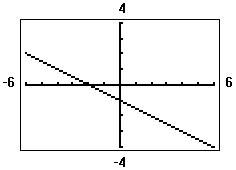
Objective: (1.3) Graph Lines Written in General Form Using Intercepts
Find an equation for the line with the given properties.
192) The solid line L contains the point (3, 2) and is parallel to the dotted line whose equation is y = 2x. Give the equation for the line L in slope-intercept form.
A) y - 2 = 2(x - 3) B) y = 2x - 1
Objective: (1.3) Find Equations of Parallel Lines
193) Parallel to the line y = -2x; containing the point (6, 6) A) y = -2x + 18 B) y - 6 = -2x - 6
Objective: (1.3) Find Equations of Parallel Lines
194) Parallel to the line x - 2y = 6; containing the point (0, 0) A) y =1 2 x B) y = 1 2 x + 6
Objective: (1.3) Find Equations of Parallel Lines
195) Parallel to the line -3x - y = 5; containing the point (0, 0) A) y =1 3 x B) y = 1 3 x C) y = -3x
Objective: (1.3) Find Equations of Parallel Lines
196) Parallel to the line y = 6; containing the point (9, 3) A) y = 3 B) y = 9
Objective: (1.3) Find Equations of Parallel Lines
197) Parallel to the line x = 5; containing the point (8, 3) A) y = 3 B) x = 8
Objective: (1.3) Find Equations of Parallel Lines
198) Parallel to the line 9x + 7y = 38; containing the point (5, -10) A) 9x + 7y = -25 B) 9x - 7y = -25
Objective: (1.3) Find Equations of Parallel Lines
y = -3
y = -2x - 18
y = 6
x = 3
y = 5
5x + 7y = 38
199) Parallel to the line -5x - 4y = -1; x-intercept = -5 A) -4x + 5y = 20 B) -5x - 4y = 20 C) -5x - 4y = 25
Objective: (1.3) Find Equations of Parallel Lines
-4x + 5y = -25
200) The solid line L contains the point (1, 3) and is perpendicular to the dotted line whose equation is y = 2x. Give the equation of line L in slope-intercept form.
y =1 2 x + 7 2
y - 3 = 2(x - 1)
Objective: (1.3) Find Equations of Perpendicular Lines
201) Perpendicular to the line y = -2x - 4; containing the point (3, 4)
y =1 2 x + 5 2
y = 2x + 5 2
Objective: (1.3) Find Equations of Perpendicular Lines
202) Perpendicular to the line y = 1 3 x + 6; containing the point (2, -4)
Objective: (1.3) Find Equations of Perpendicular Lines
203) Perpendicular to the line -4x - y = 6; containing the point (0,3 2 )
Objective: (1.3) Find Equations of Perpendicular Lines
204) Perpendicular to the line x - 9y = 8; containing the point (4, 3)
y = - 9x + 39
Objective: (1.3) Find Equations of Perpendicular Lines
205) Perpendicular to the line y = 5; containing the point (8, 1) A) x = 8
y = 1
Objective: (1.3) Find Equations of Perpendicular Lines
206) Perpendicular to the line x = -7; containing the point (4, 5) A) x = 5 B) x = 4
Objective: (1.3) Find Equations of Perpendicular Lines
y = 4
y = 5
207) Perpendicular to the line -5x - 6y = 58; containing the point (-8, 3)
A) 6x + 5y = -63
B) -8x + 6y = 58 C) -5x + 6 = -5
Objective: (1.3) Find Equations of Perpendicular Lines
208) Perpendicular to the line -3x + 7y = -41; containing the point (2, -1)
A) 7x - 3y = 11
B) 7x - 3y = -41
Objective: (1.3) Find Equations of Perpendicular Lines
209) Perpendicular to the line -5x + 3y = 2; y-intercept = 5
A) -5x + 3y = 15 B) 3x + 5y = 25
Objective: (1.3) Find Equations of Perpendicular Lines
Decide whether the pair of lines is parallel, perpendicular, or neither.
210) 3x - 2y = -14
2x + 3y = 19
A) parallel
B) perpendicular
Objective: (1.3) Find Equations of Perpendicular Lines
211) 3x - 2y = -8
2x + 3y = 2
A) parallel
B) perpendicular
Objective: (1.3) Find Equations of Perpendicular Lines
212) 6x + 2y = 8
27x + 9y = 38
A) parallel
B) perpendicular
Objective: (1.3) Find Equations of Perpendicular Lines
Write the standard form of the equation of the circle. 213) x y (1,6) (7,6)
A) (x - 4)2 + (y - 6)2 = 9
C) (x + 4)2 + (y + 6)2 = 9
Objective: (1.4) Write the Standard Form of the Equation of a Circle
-3x - 7y = 11
3x + 5y = 15
C) neither
6x - 5y = -63
C) neither
7x + 3y = 11
C) neither
B) (x + 4)2 + (y + 6)2 = 3
D) (x - 4)2 + (y - 6)2 = 3
A) (x - 2)2 + (y - 4)2 = 16
C) (x + 2)2 + (y + 4)2 = 16
Objective: (1.4) Write the Standard Form of the Equation of a Circle
B) (x + 4)2 + (y + 2)2 = 16
D) (x - 4)2 + (y - 2)2 = 16
Write the standard form of the equation of the circle with radius r and center (h, k).
215) r = 3; (h, k) = (0, 0)
A) (x - 3)2 + (y - 3)2 = 9
C) x2 + y2 = 9
Objective: (1.4) Write the Standard Form of the Equation of a Circle
216) r = 12; (h, k) = (-7, 6)
A) (x + 7)2 + (y - 6)2 = 144
B) (x - 3)2 + (y - 3)2 = 3
D) x2 + y2 = 3
(x + 7)2 + (y - 6)2 = 12
C) (x - 7)2 + (y + 6)2 = 144 D) (x - 7)2 + (y + 6)2 = 12
Objective: (1.4) Write the Standard Form of the Equation of a Circle
217) r = 7; (h, k) = (-1, 0) A) x2 + (y + 1)2 = 7 B) (x + 1)2 + y2 = 49
Objective: (1.4) Write the Standard Form of the Equation of a Circle
218) r = 9; (h, k) = (0, -2)
A) x2 + (y + 2)2 = 81 B) (x - 2)2 + y2 = 81 C) x2 + (y - 2)2 = 9 D) (x + 2)2 + y2 = 81
Objective: (1.4) Write the Standard Form of the Equation of a Circle
219) r = 5; (h, k) = (-6, -7)
A) (x + 7)2 + (y + 6)2 = 25 B) (x - 7)2 + (y - 6)2 = 25
C) (x + 6)2 + (y + 7)2 = 5 D) (x - 6)2 + (y - 7)2 = 5
Objective: (1.4) Write the Standard Form of the Equation of a Circle
220) r = 19; (h, k) = (0, 10)
A) x2 + (y + 10)2 = 19 B) x2 + (y - 10)2 = 19 C) (x + 10)2 + y2 = 361 D) (x - 10)2 + y2 = 361
Objective: (1.4) Write the Standard Form of the Equation of a Circle
Solve the problem.
221) Find the equation of a circle in standard form where C(6, -2) and D(-4, 4) are endpoints of a diameter.
A) (x - 1)2 + (y - 1)2 = 34
C) (x + 1)2 + (y + 1)2 = 34
Objective: (1.4) Write the Standard Form of the Equation of a Circle
B) (x + 1)2 + (y + 1)2 = 136
D) (x - 1)2 + (y - 1)2 = 136
222) Find the equation of a circle in standard form with center at the point (-3, 2) and tangent to the line y = 4.
A) (x - 3)2 + (y + 2)2 = 16
C) (x + 3)2 + (y - 2)2 = 4
Objective: (1.4) Write the Standard Form of the Equation of a Circle
B) (x - 3)2 + (y + 2)2 = 4
D) (x + 3)2 + (y - 2)2 = 16
223) Find the equation of a circle in standard form that is tangent to the line x = -3 at (-3, 5) and also tangent to the line x = 9.
A) (x - 3)2 + (y - 5)2 = 36
C) (x - 3)2 + (y + 5)2 = 36
Objective: (1.4) Write the Standard Form of the Equation of a Circle
Find the center (h, k) and radius r of the circle with the given equation.
224) x2 + y2 = 16
A) (h, k) = (4, 4); r = 4
C) (h, k) = (4, 4); r = 16
Objective: (1.4) Write the Standard Form of the Equation of a Circle
225) (x + 4)2 + (y - 6)2 = 36
A) (h, k) = (6, -4); r = 36
C) (h, k) = (-4, 6); r = 6
Objective: (1.4) Write the Standard Form of the Equation of a Circle
226) (x - 5)2 + y2 = 64
A) (h, k) = (0, 5); r = 64
C) (h, k) = (5, 0); r = 8
Objective: (1.4) Write the Standard Form of the Equation of a Circle
227) x2 + (y - 4)2 = 121
A) (h, k) = (4, 0); r = 11
C) (h, k) = (0, 4); r = 121
Objective: (1.4) Write the Standard Form of the Equation of a Circle
228) 3(x + 2)2 + 3(y + 5)2 = 45
A) (h, k) = (2, 5); r = 15
C) (h, k) = (-2, -5); r = 315
Objective: (1.4) Write the Standard Form of the Equation of a Circle
B) (x + 3)2 + (y + 5)2 = 36
D) (x + 3)2 + (y - 5)2 = 36
B) (h, k) = (0, 0); r = 4
D) (h, k) = (0, 0); r = 16
B) (h, k) = (6, -4); r = 6
D) (h, k) = (-4, 6); r = 36
B) (h, k) = (5, 0); r = 64
D) (h, k) = (0, 5); r = 8
B) (h, k) = (0, 4); r = 11
D) (h, k) = (4, 0); r = 121
B) (h, k) = (2, 5); r = 315
D) (h, k) = (-2, -5); r = 15
Solve the problem.
229) Find the standard form of the equation of the circle. Assume that the center has integer coordinates and the radius is an integer. A) x2 + y2 - 2x + 4y - 4 = 0
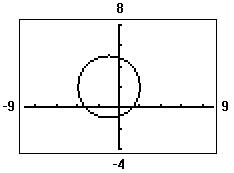
(x - 1)2 + (y + 2)2 = 9
C) x2 + y2 + 2x - 4y - 4 = 0 D) (x + 1)2 + (y - 2)2 = 9
Objective: (1.4) Write the Standard Form of the Equation of a Circle
Graph the circle with radius r and center (h, k).
230) r = 2; (h, k) = (0, 0)
Objective: (1.4) Graph a Circle
231) r = 2; (h, k) = (0, 4)
Objective: (1.4) Graph a Circle
232) r = 4; (h, k) = (4, 0)
Objective: (1.4) Graph a Circle
233) r = 3; (h, k) = (-3, -5) x-10-5510 y 10
Objective: (1.4) Graph a Circle
Graph the equation.
234) x2 + y2 = 4
Objective: (1.4) Graph a Circle
235) (x - 3)2 + (y + 2)2 = 9
Objective: (1.4) Graph a Circle
236) x2 + (y - 4)2 = 36
Objective: (1.4) Graph a Circle
237) (x - 1)2 + y2 = 36
Objective: (1.4) Graph a Circle
Find the center (h, k) and radius r of the circle. Graph the circle. 238) x2 + y2 - 10x - 10y + 34 = 0
C) (h, k) = (5, -5); r = 4
D) (h, k) = (5, 5); r = 4 x-10-5510 y 10
Objective: (1.4) Work with the General Form of the Equation of a Circle
239) x2 + y2 + 6x + 12y + 29 = 0 x-10-5510 y 10
A) (h, k) = (-3, 6); r = 4
B) (h, k) = (3, -6); r = 4 x-10-5510 y 10
C) (h, k) = (3, 6); r = 4 x-10-5510 y 10 5 -5 -10
D) (h, k) = (-3, -6); r = 4 x-10-5510 y 10 5 -5 -10
Objective: (1.4) Work with the General Form of the Equation of a Circle
Find the center (h, k) and radius r of the circle with the given equation.
240) x2 - 8x + 16 + (y - 8)2 = 36
A) (h, k) = (4, 8); r = 6
C) (h, k) = (8, 4); r = 6
B) (h, k) = (-4, -8); r = 36
D) (h, k) = (-8, -4); r = 36
Objective: (1.4) Work with the General Form of the Equation of a Circle
241) x2 - 4x + 4 + y2 - 6y + 9 = 16
A) (h, k) = (-2, -3); r = 16
C) (h, k) = (-3, -2); r = 16
B) (h, k) = (3, 2); r = 4
D) (h, k) = (2, 3); r = 4
Objective: (1.4) Work with the General Form of the Equation of a Circle
242) x2 + y2 - 10x + 16y + 89 = 64
A) (h, k) = (8, -5); r = 64
C) (h, k) = (5, -8); r = 8
B) (h, k) = (-8, 5); r = 8
D) (h, k) = (-5, 8); r = 64
Objective: (1.4) Work with the General Form of the Equation of a Circle
243) x2 + y2 + 12x + 8y = -3
A) (h, k) = (-6, -4); r = 7
C) (h, k) = (-4, -6); r = 7
B) (h, k) = (6, 4); r = 49
D) (h, k) = (4, 6); r = 49
Objective: (1.4) Work with the General Form of the Equation of a Circle
244) 4x2 + 4y2 - 12x + 16y - 5 = 0
A) (h, k) = (3 2 , 2); r= 35 2
C) (h, k) = (3 2 , 2); r = 30 2
B) (h, k) = (3 2 , -2); r = 30 2
D) (h, k) = (3 2 , -2); r = 35 2
Objective: (1.4) Work with the General Form of the Equation of a Circle
Find the general form of the equation of the the circle.
245) Center at the point (-4, -3); containing the point (-3, 3)
A) x2 + y2 + 8x + 6y - 12 = 0
C) x2 + y2 + 6x + 8y - 17 = 0
B) x2 + y2 - 6x + 6y - 12 = 0
D) x2 + y2 + 6x - 6y - 17 = 0
Objective: (1.4) Work with the General Form of the Equation of a Circle
246) Center at the point (2, -3); containing the point (5, -3)
A) x2 + y2 + 4x - 6y + 4 = 0
C) x2 + y2 + 4x - 6y + 22 = 0
B) x2 + y2 - 4x + 6y + 4 = 0
D) x2 + y2 - 4x + 6y + 22 = 0
Objective: (1.4) Work with the General Form of the Equation of a Circle
247) Center at the point (-4, -2); tangent to x-axis
A) x2 + y2 + 8x + 4y + 4 = 0
C) x2 + y2 + 8x + 4y + 16 = 0
B) x2 + y2 - 8x - 4y + 16 = 0
D) x2 + y2 + 8x + 4y + 24 = 0
Objective: (1.4) Work with the General Form of the Equation of a Circle
Solve the problem.
248) If a circle of radius 1 is made to roll along the x-axis, what is the equation for the path of the center of the circle?
A) x = 1 B) y = 2
C) y = 1 D) y = 0
Objective: (1.4) Work with the General Form of the Equation of a Circle
249) Earth is represented on a map of the solar system so that its surface is a circle with the equation x2 + y2 + 4x + 2y - 3,716 = 0. A weather satellite circles 0.5 units above the Earth with the center of its circular orbit at the center of the Earth. Find the general form of the equation for the orbit of the satellite on this map.
A) x2 + y2 + 4x + 2y + 4.75 = 0
B) x2 + y2 - 4x - 2y - 3,777.25 = 0 C) x2 + y2 + 4x + 2y - 55.75 = 0
x2 + y2 + 4x + 2y - 3,777.25 = 0
Objective: (1.4) Work with the General Form of the Equation of a Circle
250) Find an equation of the line containing the centers of the two circles x2 + y2 - 2x - 2y + 1 = 0and x2 + y2 - 8x - 12y + 48 = 0
A) -5x - 3y + 2 = 0 B) -5x
Objective: (1.4) Work with the General Form of the Equation of a Circle
251) A wildlife researcher is monitoring a black bear that has a radio telemetry collar with a transmitting range of 17 miles. The researcher is in a research station with her receiver and tracking the bear's movements. If we put the origin of a coordinate system at the research station, what is the equation of all possible locations of the bear where the transmitter would be at its maximum range?
x2 - y2 = 17
Objective: (1.4) Work with the General Form of the Equation of a Circle
252) If a satellite is placed in a circular orbit of 440 kilometers above the Earth, what is the equation of the path of the satellite if the origin is placed at the center of the Earth (the diameter of the Earth is approximately 12,740 kilometers)?
A) x2 + y2 = 40,576,900
C) x2 + y2 = 193,600
B) x2 + y2 = 173,712,400
D) x2 + y2 = 46,376,100
Objective: (1.4) Work with the General Form of the Equation of a Circle
253) A power outage affected all homes and businesses within a 20 mi radius of the power station. If the power station is located 10 mi north of the center of town, find an equation of the circle consisting of the furthest points from the station affected by the power outage.
A) x2 + (y - 10)2 = 20 B) x2 + (y - 10)2 = 400
C) x2 + (y + 10)2 = 400 D) x2 + y2 = 400
Objective: (1.4) Work with the General Form of the Equation of a Circle
254) A power outage affected all homes and businesses within a 4 mi radius of the power station. If the power station is located 2 mi west and 4 mi north of the center of town, find an equation of the circle consisting of the furthest points from the station affected by the power outage.
A) (x - 2)2 + (y + 4)2 = 16
C) (x + 2)2 + (y + 4)2 = 16
(x - 2)2 + (y - 4)2 = 16
(x + 2)2 + (y - 4)2 = 16
Objective: (1.4) Work with the General Form of the Equation of a Circle
255) A Ferris wheel has a diameter of 380 feet and the bottom of the Ferris wheel is 15 feet above the ground. Find the equation of the wheel if the origin is placed on the ground directly below the center of the wheel, as illustrated.

Objective: (1.4) Work with the General Form of the Equation of a Circle
Write a general formula to describe the variation.
256) v varies directly with t; v = 10 when t = 16
v = 16
Objective: (1.5) Construct a Model Using Direct Variation
257) A varies directly with t2; A = 64 when t = 4 A) A = 4 t2
A = 4t2
Objective: (1.5) Construct a Model Using Direct Variation
A = 16t2
258) z varies directly with the sum of the squares of x and y; z = 30 when x = 18 and y = 24
z2 = x2 + y2
(x2 + y2)
Objective: (1.5) Construct a Model Using Direct Variation
If y varies directly as x, write a general formula to describe the variation.
259) y = 5 when x = 45 A) y = 9x
y = x + 40
Objective: (1.5) Construct a Model Using Direct Variation
z = 1
+ y2)
A = 16 t2
260) y = 36 when x = 32
y = 8 9 x
y = 4x
Objective: (1.5) Construct a Model Using Direct Variation
261) y = 3 when x = 1 7
y = 1 21 x
y = x + 20 7
Objective: (1.5) Construct a Model Using Direct Variation
262) y = 1.2 when x = 0.6
A) y = x + 0.6
y = 2x
Objective: (1.5) Construct a Model Using Direct Variation
263) y = 0.4 when x = 2 A) y = x - 1.6
y = 0.2x
Objective: (1.5) Construct a Model Using Direct Variation
Write a general formula to describe the variation.
y = 9 8 x
y = x + 4
y = 1 3 x
y = 0.5x
y = 0.6x
y = 0.4x
y = 5x
264) The volume V of a right circular cone varies directly with the square of its base radius r and its height h. The constant of proportionality is 1 3 π.
V = 1 3 r2h B) V = 1 3 πr2h2
Objective: (1.5) Construct a Model Using Direct Variation
V = 1
265) The surface area S of a right circular cone varies directly as the radius r times the square root of the sum of the squares of the base radius r and the height h. The constant of proportionality is π.
S = πrr2h2
Objective: (1.5) Construct a Model Using Direct Variation
Solve the problem.
266) In simplified form, the period of vibration P for a pendulum varies directly as the square root of its length L. If P is 0.75 sec. when L is 9 in., what is the period when the length is 36 in.?
A) 24 sec
B) 144 sec
Objective: (1.5) Construct a Model Using Direct Variation
C) 1.5 sec
D) 9 sec
267) The amount of water used to take a shower is directly proportional to the amount of time that the shower is in use. A shower lasting 24 minutes requires 9.6 gallons of water. Find the amount of water used in a shower lasting 4 minutes.
A) 10 gal
B) 1.6 gal
Objective: (1.5) Construct a Model Using Direct Variation
C) 2.4 gal
D) 57.6 gal
268) If the resistance in an electrical circuit is held constant, the amount of current flowing through the circuit is directly proportional to the amount of voltage applied to the circuit. When 8 volts are applied to a circuit, 200 milliamperes (mA) of current flow through the circuit. Find the new current if the voltage is increased to 14 volts.
A) 350 mA
B) 375 mA
Objective: (1.5) Construct a Model Using Direct Variation
C) 336 mA
D) 112 mA
269) The amount of gas that a helicopter uses is directly proportional to the number of hours spent flying. The helicopter flies for 3 hours and uses 36 gallons of fuel. Find the number of gallons of fuel that the helicopter uses to fly for 5 hours.
A) 72 gal
B) 60 gal
Objective: (1.5) Construct a Model Using Direct Variation
C) 15 gal
D) 65 gal
270) The distance that an object falls when it is dropped is directly proportional to the square of the amount of time since it was dropped. An object falls 288 feet in 3 seconds. Find the distance the object falls in 5 seconds.
A) 15 ft
B) 480 ft
Objective: (1.5) Construct a Model Using Direct Variation
Write a general formula to describe the variation.
271) A varies inversely with x2; A = 10 when x = 4
A = 40x2
Objective: (1.5) Construct a Model Using Inverse Variation
C) 160 ft
D) 800 ft
Write an equation that expresses the relationship. Use k as the constant of variation.
272) g varies inversely as y.
Objective: (1.5) Construct a Model Using Inverse Variation
273) g varies inversely as the square of y.
Objective: (1.5) Construct a Model Using Inverse Variation
If y varies inversely as x, write a general formula to describe the variation.
274) y = 5 when x = 7
y = 1
Objective: (1.5) Construct a Model Using Inverse Variation
275) y = 15 when x = 5 A) y = 1 75x
y = 3x
Objective: (1.5) Construct a Model Using Inverse Variation
y = x 75
y = 75 x
276) y = 21 when x = 1 3
y = x 7
y = 7 x
Objective: (1.5) Construct a Model Using Inverse Variation
277) y = 1 9 when x = 45 A) y = 5 x
y = x 5
Objective: (1.5) Construct a Model Using Inverse Variation
278) y = 0.5 when x = 0.2 A) y = 2.5x
y = 0.1 x
Objective: (1.5) Construct a Model Using Inverse Variation
Solve the problem.
279) x varies inversely as v, and x = 56 when v = 6. Find x when v = 48 A) x = 42
x = 8
Objective: (1.5) Construct a Model Using Inverse Variation
280) x varies inversely as y2, and x = 2 when y = 12. Find x when y = 2.
x = 72
x = 6
Objective: (1.5) Construct a Model Using Inverse Variation
y = 63x
y = 1 7x
y = 1 405 x
y = 1 5x
y = 10x
y = 10 x
x = 36
x = 7
x = 24
x = 8
281) When the temperature stays the same, the volume of a gas is inversely proportional to the pressure of the gas. If a balloon is filled with 180 cubic inches of a gas at a pressure of 14 pounds per square inch, find the new pressure of the gas if the volume is decreased to 30 cubic inches.
A) 78 psi
Objective: (1.5) Construct a Model Using Inverse Variation
282) The amount of time it takes a swimmer to swim a race is inversely proportional to the average speed of the swimmer. A swimmer finishes a race in 100 seconds with an average speed of 3 feet per second. Find the average speed of the swimmer if it takes 60 seconds to finish the race. A) 5 ft/sec B) 7 ft/sec
4 ft/sec
6 ft/sec
Objective: (1.5) Construct a Model Using Inverse Variation
283) If the force acting on an object stays the same, then the acceleration of the object is inversely proportional to its mass. If an object with a mass of 20 kilograms accelerates at a rate of 7 meters per second per second (m/sec2) by a force, find the rate of acceleration of an object with a mass of 2 kilograms that is pulled by the same force. A) 70 m/sec2 B) 60 m/sec2 C) 63 m/sec2
7 10 m/sec2
Objective: (1.5) Construct a Model Using Inverse Variation
284) If the voltage, V, in an electric circuit is held constant, the current, I, is inversely proportional to the resistance, R. If the current is 350 milliamperes (mA) when the resistance is 3 ohms, find the current when the resistance is 15 ohms.
A) 1,745 mA
B) 210 mA
Objective: (1.5) Construct a Model Using Inverse Variation
C) 70 mA
D) 1,750 mA
285) While traveling at a constant speed in a car, the centrifugal acceleration passengers feel while the car is turning is inversely proportional to the radius of the turn. If the passengers feel an acceleration of 4 feet per second per second (ft/sec2) when the radius of the turn is 60 feet, find the acceleration the passengers feel when the radius of the turn is 120 feet.
A) 4 ft/sec2
B) 2 ft/sec2
Objective: (1.5) Construct a Model Using Inverse Variation
Write a general formula to describe the variation.
C) 3 ft/sec2
D) 5 ft/sec2
286) The square of G varies directly with the cube of x and inversely with the square of y; G = 5 when x = 2 and y = 2
A) G2 = 25 32 (x3 + y2) B) G2 = 25 2 x3 y2
G2 = 5 x3 y2
Objective: (1.5) Construct a Model Using Joint Variation or Combined Variation
287) R varies directly with g and inversely with the square of h; R = 3 when g = 3 and h = 5.
A) R = 5 g h2
B) R = 5h2 g C) R = 25 g h2
Objective: (1.5) Construct a Model Using Joint Variation or Combined Variation
288) z varies jointly as the cube root of x and the cube of y; z = 3 when x = 27 and y = 5.
G2 = 50 y3 x2
D) R = 25gh2
Objective: (1.5) Construct a Model Using Joint Variation or Combined Variation
289) The centrifugal force F of an object speeding around a circular course varies directly as the product of the object's mass m and the square of it's velocity v and inversely as the radius of the turn r.
A) F = kmv r B) F = kmr v2 C) F = km2v r D) F = kmv2 r
Objective: (1.5) Construct a Model Using Joint Variation or Combined Variation
290) The safety load λ of a beam with a rectangular cross section that is supported at each end varies directly as the product of the width W and the square of the depth D and inversely as the length L of the beam between the supports.
A) λ = kL WD2 B) λ = k(W + D2) L C) λ = kWD2 L D) λ = kWD L
Objective: (1.5) Construct a Model Using Joint Variation or Combined Variation
291) The illumination I produced on a surface by a source of light varies directly as the candlepower c of the source and inversely as the square of the distance d between the source and the surface.
A) I = kc2 d2
B) I = kd2 c
C) I = kc d2
Objective: (1.5) Construct a Model Using Joint Variation or Combined Variation
Solve the problem.
D) I = kcd2
292) The volume V of a given mass of gas varies directly as the temperature T and inversely as the pressure P. A measuring device is calibrated to give V = 456 in3 when T = 380° and P = 10 lb/in2. What is the volume on this device when the temperature is 320° and the pressure is 20 lb/in2?
A) V = 192 in3
B) V = 172 in3
C) V = 16 in3
Objective: (1.5) Construct a Model Using Joint Variation or Combined Variation
D) V = 212 in3
293) The time in hours it takes a satellite to complete an orbit around the earth varies directly as the radius of the orbit (from the center of the earth) and inversely as the orbital velocity. If a satellite completes an orbit 670 miles above the earth in 15 hours at a velocity of 35,000 mph, how long would it take a satellite to complete an orbit if it is at 1,100 miles above the earth at a velocity of 26,000 mph? (Use 3960 miles as the radius of the earth.)
A) 33.15 hr
B) 22.07 hr
C) 4.8 hr D) 220.68 hr
Objective: (1.5) Construct a Model Using Joint Variation or Combined Variation
294) The pressure of a gas varies jointly as the amount of the gas (measured in moles) and the temperature and inversely as the volume of the gas. If the pressure is 1,248 kiloPascals (kPa) when the number of moles is 4, the temperature is 320° Kelvin, and the volume is 480 cc, find the pressure when the number of moles is 1, the temperature is 280° K, and the volume is 60 cc.
A) 1,014 kPa
B) 2,184 kPa C) 1,092 kPa D) 2,340 kPa
Objective: (1.5) Construct a Model Using Joint Variation or Combined Variation
295) Body-mass index, or BMI, takes both weight and height into account when assessing whether an individual is underweight or overweight. BMI varies directly as one's weight, in pounds, and inversely as the square of one's height, in inches. In adults, normal values for the BMI are between 20 and 25. A person who weighs 178 pounds and is 72 inches tall has a BMI of 24.14. What is the BMI, to the nearest tenth, for a person who weighs 130 pounds and who is 65 inches tall?
A) 21.6
B) 22
C) 20.9
Objective: (1.5) Construct a Model Using Joint Variation or Combined Variation
D) 21.2
296) The amount of paint needed to cover the walls of a room varies jointly as the perimeter of the room and the height of the wall. If a room with a perimeter of 30 feet and 8-foot walls requires 2.4 quarts of paint, find the amount of paint needed to cover the walls of a room with a perimeter of 60 feet and 10-foot walls.
A) 6 qt
B) 12 qt
C) 60 qt D) 600 qt
Objective: (1.5) Construct a Model Using Joint Variation or Combined Variation
297) The power that a resistor must dissipate is jointly proportional to the square of the current flowing through the resistor and the resistance of the resistor. If a resistor needs to dissipate 63 watts of power when 3 amperes of current is flowing through the resistor whose resistance is 7 ohms, find the power that a resistor needs to dissipate when 7 amperes of current are flowing through a resistor whose resistance is 4 ohms.
A) 196 watts
B) 84 watts
C) 28 watts D) 112 watts
Objective: (1.5) Construct a Model Using Joint Variation or Combined Variation
298) While traveling in a car, the centrifugal force a passenger experiences as the car drives in a circle varies jointly as the mass of the passenger and the square of the speed of the car. If a passenger experiences a force of 220.5 newtons (N) when the car is moving at a speed of 70 kilometers per hour and the passenger has a mass of 50 kilograms, find the force a passenger experiences when the car is moving at 80 kilometers per hour and the passenger has a mass of 100 kilograms.
A) 704 N
640 N
576 N
Objective: (1.5) Construct a Model Using Joint Variation or Combined Variation
512 N
299) The amount of simple interest earned on an investment over a fixed amount of time is jointly proportional to the principle invested and the interest rate. A principle investment of $3,000.00 with an interest rate of 6% earned $540.00 in simple interest. Find the amount of simple interest earned if the principle is $3,700.00 and the interest rate is 8%.
A) $888.00
Objective: (1.5) Construct a Model Using Joint Variation or Combined Variation
300) The voltage across a resistor is jointly proportional to the resistance of the resistor and the current flowing through the resistor. If the voltage across a resistor is 56 volts (V) for a resistor whose resistance is 8 ohms and when the current flowing through the resistor is 7 amperes, find the voltage across a resistor whose resistance is 9 ohms and when the current flowing through the resistor is 2 amperes.
18 V
63 V
16 V
Objective: (1.5) Construct a Model Using Joint Variation or Combined Variation
14 V
AnswerKey
Testname:SULLIVANPREC12ECHAPT1
1) A 2) B 3) C 4) D
5) B 6) B
7) A 8) D 9) D 10) B 11) A 12) C 13) B 14) D 15) D 16) B 17) D
18) C 19) D 20) C 21) D 22) B 23) B 24) C
25) A 26) A 27) A 28) B
29) C 30) D
31) A
32) A 33) B 34) B 35) B
36) A 37) B
38) C 39) B
40) A
41) B
42) C
43) A 44) C
45) D 46) C
47) A 48) C
49) D
50) D
51) D 52) B 53) B 54) B 55) B 56) B 57) B 58) D 59) B 60) C 61) B 62) A 63) D 64) C 65) B 66) A 67) A 68) B 69) A 70) D 71) C 72) A 73) C 74) D 75) A 76) D 77) A 78) D 79) B 80) D 81) C 82) D 83) C 84) B 85) D 86) C 87) C 88) A 89) C 90) C 91) D 92) D 93) B 94) B 95) A 96) B 97) E 98) B 99) B 100) C
101) D 102) D 103) E 104) C 105) B 106) C 107) E 108) C 109) E 110) D 111) A 112) C 113) B 114) A 115) D 116) B 117) A 118) B 119) B 120) A 121) B 122) A 123) C 124) D 125) B 126) A 127) A 128) B 129) D 130) D 131) A 132) B 133) D 134) B 135) D 136) D 137) D 138) C 139) D 140) D 141) C 142) D 143) D 144) C 145) A 146) A 147) B 148) D 149) B 150) B
151) B 152) C 153) B 154) C 155) A 156) B 157) B 158) B 159) D 160) C 161) C 162) D 163) B 164) A 165) C 166) D 167) C 168) D 169) D 170) A 171) B 172) A 173) C 174) A 175) B 176) A 177) C 178) B 179) D 180) B 181) C 182) C 183) B 184) D 185) A 186) D 187) C 188) A 189) D 190) D 191) D 192) D 193) A 194) D 195) C 196) A 197) B 198) A 199) C 200) A
AnswerKey
Testname:SULLIVANPREC12ECHAPT1
201) C
202) A
203) B
204) A
205) A
206) D
207) D
208) D
209) B
210) B
211) B
212) A
213) A
214) D
215) C
216) A
217) B
218) A
219) C
220) B
221) A
222) C
223) A
224) B
225) C
226) C
227) B
228) D
229) D
230) D
231) A
232) A
233) B
234) A
235) D
236) B
237) C
238) D
239) D
240) A
241) D
242) C
243) A
244) B
245) A
246) B
247) C
248) C
249) D
250) B
251) D
252) D
253) B 254) D
255) D 256) B 257) B 258) D 259) C 260) C 261) C 262) B 263) B 264) C 265) B 266) C 267) B 268) A 269) B 270) D 271) C 272) C 273) D 274) D 275) D 276) B 277) A 278) B 279) D 280) A 281) D 282) A 283) A 284) C 285) B 286) B 287) C 288) D 289) D 290) C 291) C 292) A 293) B 294) B 295) A 296) A
297) A 298) C
299) A 300) A
